Don't wanna be here? Send us removal request.
Photo




Nonverbal actions/expressions are the ones communicated without saying a word and these are hugging someone, your presence, and your smile. All the things mentioned are the ones that I often use as these show my care and feelings towards my loved ones. These nonverbal cues help me express myself in a way that I can’t express in words. Just like giving a genuine hug, it is more than just a gesture of love and kindness. It can cheer you and relieve depression. Hugs double as a communication method; it can communicate anything from “I’m sorry” to “I love you”. In fact, hugs can say a lot more than any amount of words can. In a hug, both the giver and the receiver feel the love. Talking about presence, It helps me communicate or express myself that “I am always here for you” and “I care for you”. Lastly, is the smile. Smiling does not only improve my personal health and well-being, but also significantly impacts those around you. The power of a smile must not be underestimated. A smile shares hope, affection, and peace. A smile has the power to bring light in the darkness, to bring positive energy in the day, to reduce stress in life and to bring greater happiness in to the world. These nonverbal cues are really important since it really helps us express ourselves in a way that words can’t.
I believe that actions truly speak louder than words. Very much like in progress, if you want progress then you should focus on actions since a man is made up of his actions. In addition, your actions will help in deciding your character and your actions are also proportional to progress.
Everybody in life wants to progress, yet for that one needs to emerge from their usual range of familiarity and make fitting actions for it. One can't anticipate the future, but you have a chance to create it since your future lies in your present. The choices you take in your current will outline your future. For example, students talk about grades, they all want an A in academics, but if you are not studying how can you imagine getting an A grade. Similarly, the world’s fastest man, Usain Bolt has achieved this status not just by thinking to run fast, but he practiced a lot to get that speed. He had worked on his physique and fitness for getting that pace in a race.
Basically, I might want to emphasize the significance of actions throughout everyday life. Each individual who has made progress in life had done a great deal of difficult work for it. In this way, making actions in life is obviously superior to simply talking about it.
0 notes
Text
A SPORTS BLOG: Women's Rhythmic Gymnastics Rio 2016
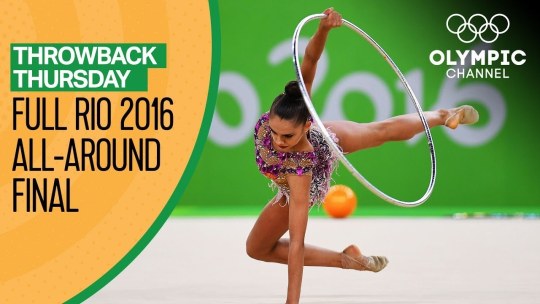
Video Link: https://www.youtube.com/watch?v=MaxT2vguGXQ
Introduction
Rhythmic gymnastics is one of three disciplines in the sport of gymnastics. The others are artistic gymnastics and trampoline. Female athletes perform expressive and acrobatic moves with the aid of handheld apparatus — a hoop, ball, pair of clubs and ribbon.
Court Dimension
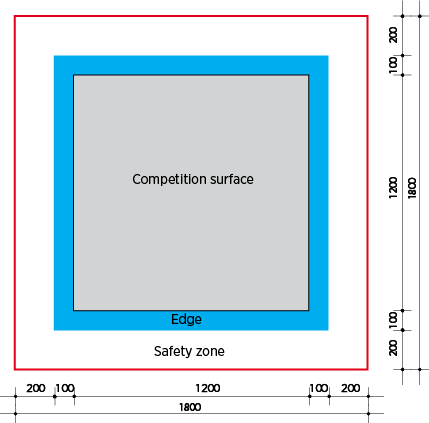
2016 Rio Women’s Rhythmic Gymnastics was held at the Arena Olímpica do Rio. For its court dimensions, the single case coverage area is 7m x 7m, and the duo, trio, and group performance area are 10m x 10m. However, normally, the competition area is 13 m x 13 m (approx. 42.5ft. square). A black delimitation strip surrounds the competition field. The boundary is horizontal, still, and equal in height to the output area. It has a surface area of 100cm. The safety zone is also 100cm in length.
Equipment

Costume
Gymnasts usually use leotards or singlets. Leotards can be short-sleeved or long-sleeved and cut at the groin area much like a bikini so that there will be no hindrance to an athlete’s flexibility or movement.
Hairnet
This is used to make the athlete look neat and to prevent from the hair to tangle.
Toe shoes
Toe shoes are specially designed professional shoes for rhythmic gymnastics. They cover toes while the heels remain open. Silicone elastic band fixes the toe of the shoes around the heel.
Hoop
Hoops are used in conjunction with various gymnastics movements like splits and handstands to increase difficulty. They are made out of either wood or plastic material. It weighs 300 grams and has an interior diameter of 80 to 90 inches.
Ball
The ball is made of rubber or synthetic has a diameter of 18 to 20 centimeters, and its minimum weight is 4000 grams. The balls are made of rubber or synthetic plastic material. They are often utilized by the gymnasts in their routines to showcase their balance and flow.
Clubs
They are built by wrapping a thin layer of plastic or a similar material around an insulated thin rod. They usually weigh 150 grams each and have a length of 15.6 to 19.5 inches and have a diameter of 3 centimeters max for the head of the club. In competitions, they are juggled, thrown, tossed, or rolled to and from a variety of body parts – hands, feet, legs, back, etc. They’re made of either wood or synthetic material.
Ribbon
Ribbons are made of cloth or similar fabric. They usually are measured to be 4 to 6 meters in length – whilst the attached stick to the ribbon is usually 1 meter long. They are comprised of snakes, spirals, swings, circles, throws and catches, and figure-eight movements. In the end, the ribbon must remain constantly in motion whilst doing routines. Usually, ribbons weigh 35 grams.
Basic Skills
Beginner Rhythmic
Correct Body Position. This is absolutely critical to progress in rhythmic gymnastics. All body and equipment skills require the gymnast to use the correct body position for safe completion.
Arm Positions. Proper carriage of the arms is also critical for rhythmic gymnastics. For beginners, the arms may be held in either first or second position or with the hands on the hips.
Beginner Rope Technique
What to Use. Any type of rope which does not have handles may be sued for rhythmic gymnastics. The most suitable materials are hemp or a pliable synthetic fiber. Other materials may be too light or flimsy to hold a good shape during the swinging or circling movements. To find the appropriate length of rope for the student, have her stand in the middle of the rope and pull the ends up one each side of the body. The ends of the rope should be knotted and should reach approximately to the armpits. If you are cutting the rope to achieve the proper length, you may cover the ends with tape to avoid fraying.
Skill Groups. You will find the following 5 skill groups presented in this curriculum:
Swings (1-handed, 2-handed)
Circles (1-handed, 2-handed)
Forward jumps/skips
Releases
Exchanges
Grip. Throughout the rope curriculum, proper grip of the rope should be stressed. The rope is held lightly with the thumb and index finger wrapped around the rope just below the knots. Gripping the rope too tightly will affect the pattern of the rope and cause the gymnast to perform skills out of the correct plane.
Notes:
When performing one-handed skills with the rope, the free arm should be placed on the hip or extended to the side at all times.
Avoid hitting or brushing the rope against the floor when performing rope skills.
Jumping rope is a terrific conditioning activity. Try placing your rope activity either and the beginning of class for a good aerobic warm-up or at the end of class for a strong conditioning exercise.
Beginner Hoop Technique
What to Use. Any ordinary plastic “hula hoop” can be modified to suit the rhythmic gymnastics class. A minimum weight of 300 grams can be achieved by wrapping the hoop with plastic or electrical tape. The “noisemakers” inside the hoop can easily be removed by removing the staples at the joint, pouring out the contents, and reassembling the hoop. Of course, official hoops for rhythmic gymnastics are available if you prefer. To find the appropriate size hoop, stand the hoop on end and measure the top of the hoop approximately to the hip bone.
Skill Groups. You will find the following 6 skill groups within this curriculum:
Swings
Circles
Exchanges
Rolls
Passing through the hoop
Spins
Notes:
When performing one-handed skills with the rope, the free arm should be placed on the hip or extended to the side at all times. Hoop offers much room for creativity because the range of movement is uniquely diverse. Everyone loves to do the “hula hoop”, but look for the excitement as your students discover the endless variety of skills which can be performed with the hoop.
Beginner Ball Technique
What to Use. Balls designed specifically for rhythmic gymnastics are inexpensive and come in many different sizes and colors. Ordering an assortment of balls from a rhythmic supplier is a great investment for your program. The smallest sizes available (approximately 16cm diameter) are perfect for small hands. Larger sizes should be used to fit growing hands. The largest regulation size is 20cm diameter. Balls larger than this should not be used. If you currently have other sport balls in your gym, these can be used. Make sure they are not too light (a 350-gram minimum is a good guideline) and that they are not too “bouncy.” To check for proper inflation, press on the ball with the heel of your hand. If the ball does not give with the pressure, deflate it slightly.
Skill groups. The following 6 skill groups are included in this curriculum:
Swings
Exchanges
Rolls (on the ground, on the body)
Bounces
Rotations
Tosses and Catches
Grip. Throughout the ball curriculum reference is made to “correct grip.” Mastering the correct grip is critical to learning proper ball technique. Below are the rules for holding the ball:
Ball rests on the palm of the hand
Fingers are relaxed, not squeezed together, and follow the shape of the ball
Ball is not gripped with the thumb or any other part of the hand
Ball does not rest against the wrist or the forearm
Notes:
Ball lends itself well to group activities because it is easily exchanged with a partner or in a group setting. Be creative with your class organization and try using different set-ups to encourage cooperation among your students.
Beginner Ribbon Technique
What to Use. Ribbons are the most recognized piece of rhythmic apparatus and usually the first thing your students will want to “play” with. Ribbons that are too long for the student, however, can quickly cause frustration when it constantly becomes knotted or wrapped around the struggling gymnast. Whether you make your own ribbons or buy them from your equipment supplier, be sure they are long enough to seethe patterns being created, yet short enough for your smallest participant to manipulate. Be sure to sew the end of the ribbons after they are cut to avoid fraying. To make your own ribbons, use a medium weight satin or satin/polyester blend ribbon approximately 5cm wide. The stick can be made from dowels or the ends of fishing rods 50-60cm long. Shorter sticks may be used for preschoolers. Ribbons should be attached with a fishing swivel to a ring of some type (i.e. eyelet screw) at the end of the stick.
Skill Groups. The following 4 skill groups are used in this curriculum:
Swings
Large Circles
Snakes
Exchanges
Grip. To show correct patterns with the ribbon, it is necessary to first master the correct grip of the ribbon stick. Below are the rules for holding the ribbon stick:
Stick is held between the thumb and middle finger
Index finger points down the stick, fourth and fifth fingers wrap lightly around the stick
End of the stick should be hidden in the palm of the hand
Notes:
The flowing movements of the ribbon can deceive observers into thinking that the ribbon is easy to manipulate. On the contrary, ribbon requires a good amount of arm strength to properly create the beautiful patters. Encourage your students to really “work” the ribbon so the whole length can be involved.
Technical and Tactical Skills of each team
Watching all throughout the game, most competitors had their own tactics on presenting their performance. They have done such beautiful movements especially with their mastery in using the props such as hoop, balls, clubs and ribbon. They have done wonderful jump, leaps, spins and hand rotations. Some participants made mistake, but it was not a hindrance for them to stop presenting, we are all humans and we all make mistakes, they just acted like nothing happened and continued the show with such graceful movements together with their aesthetic smiles. Through the different individuals, they mesmerized the audience and judges with their unique capabilities and performances. Thinking about the athletes while watching the video, I can really say that gymnastic is really a hard sport, it may seem easy for us to look but behind those successful presentations are numerous failures and tears they’ve been through in order to come up with such spectacular performance.
Rules of the Game
Rhythmic gymnastics combines ballet, dance and acrobatics with expressive movement and manipulating apparatuses such as the ball, clubs, hoop, and ribbon.
This sport is ideal for developing flexibility, strength, as well as body coordination. It stems from various dance styles and exercise regimes that share the common idea of expressive movement as an exercise tool.
> Individual programme
During the individual programme, an athlete will manipulate only one of these five apparatuses at a time - rope, hoop, ball, clubs and ribbon. One apparatus is rotated out of contention every two years, with the gymnast required to compete on the remaining four events.
> Music and Choreography
All routines must be performed with music, with only short pauses of music allowed. The choreography must centre around a theme developed from beginning to end using a variety of body movements and the handling of apparatuses.
> Movement Rules:
o Leaps and jumps
All leaps and jumps must be of a good height, have a precise shape and good amplitude.
All leaps with the back arched must have the head in contact with the leg.
o Balances
All balances must be performed on the toes or the knee. These must be held clearly and have a good, fixed shape.
o Pivots
All pivot combinations must be performed entirely on the toes without heel support.
> Basic Rule:
Each gymnast must perform choreographed routines using each of the following four pieces of apparatus:
Ball
Hoop
Clubs
Ribbon
> Scoring
Performances in rhythmic gymnastics are given a maximum of 20, comprising difficulty (D) and execution (E) scores.
The D score is based on each performance element, including leaps, jumps and use of apparatus. These D scores are averaged to give a score out of 10.
The E score is based on how well the routine was executed either by the individual or the group. The final number is an average of the middle three scores awarded by the judges.
The D and E scores are combined at this stage, giving a mark out of 20. Then, any deductions are taken away. The list of instant deductions is incredibly long and complex in rhythmic gymnastics. Competitors can be penalized for anything from breaking the apparatus to landing heavily on their feet.
> Judging
o Good Form and Execution: In elements such as leaps and jumps, a gymnast’s toes should be pointed. Her legs should be straight. She should maintain tightness in her body and each skill should look planned.
o Control of the Apparatus: The gymnast should keep her equipment moving and look as if she has complete control. Dropping the apparatus is a deduction. If the equipment rolls away or off the floor, more penalties are incurred.
o Flexibility: Rhythmic gymnasts should achieve a minimum of a 180-degree split on split leaps and jumps, and often they go much further. A great rhythmic gymnast will exhibit flexibility in her back, legs, and shoulders.
o Choreography: The intricacies of movement are essential in rhythmic gymnastics. Each routine should be a performance, and the gymnast’s music should be a necessary part of the routine, not simply used as background music.
o The Uniqueness of the Routine: A great gymnast will perform a routine that looks different from the rest. It will have something special about it, risky throws and catches, complicated choreography, extreme flexibility, or simply unique skills from others performed in the competition.
How to officiate the sport
Meet Referee
Conducts the judge’s education meeting prior to the event,
Makes the panel assignments or conducts a draw,
Has ultimate control over technical decisions,
Judges every routine within human possibility,
Can question a panel score, even if the judges are in range, if she feels it is not appropriate,
Can call a conference of either judging panel, can make the decision to go to base score,
Keeps track (with the help of an assigned volunteer secretary) of all scores and rankings,
Determines the number of sessions in association with the meet director,
Makes sure the timers and line judges are knowledgeable about the rules and their function,
Serves as the spokesperson for the judging panels to the organizing host and the participants,
Makes sure the Head Judges review the official score sheets before signing them,
Mediates all professional disagreements, and has the final response,
Is responsible for any media involvement concerning the judges,
Respond to any written inquires before a session has ended.
Head Judge
Attends pre-competition education session,
Makes sure judges scores are within the proper range,
Requests the MR to call a conference if there is a disagreement,
Keeps track of rank order for assigned events.
Acting Panel Judge
Attends pre-competition education session,
Judges each routine assigned with undivided attention.
Line Judge
A Line Judge determines if the athlete and the apparatus are within the boundaries of the field of play. There are two line judges for each individual routine, and you will be responsible for the two lines that are in your “corner”of the carpet. Each judge is responsible for the line to their right. The red line denotes the warning area, and if the athlete or their apparatus touches the line they are still in bounds. If any part of the athlete’s body and / or apparatus touches the floor outside of the red line, then she is out-of-bounds and the judge immediately hold up one flag high in the air for a few seconds. If both the apparatus and gymnast touches the floor outside of the red line, then immediately hold up both flags high in the air for a couple of seconds.
Timers
Each timer requires a stop watch that indicates the minutes, seconds and milliseconds, a rotation order, timer judge chits and a pen.
Procedure to follow as a Timer Judge:
Have a Rotation List available.
Check off each gymnast as they are announced so that you know which gymnast is on the floor.
Start the timer when the gymnast starts moving (or first gymnast in group), and stop the timer when the gymnast stops moving (or the last gymnast in group). Record the time to the millisecond on the rotation order. For example, 1:30:05. If the routine is over or less than the required time (times to be provided by the Meet Director), then also complete the Timer Judge Chit.
Give the timer judge slip to a runner to take to the head judge for inclusion in the scoring papers.
Judge Administrator
The primary responsibilities of the Judge Administrator are to act as the GCG representative at EC and CC, to ensure that all Judge Rules and Technical Rules are followed, and to ensure that all score ranges are within FIG requirements. The JA does not act as a reference judge and does not score the routines.
Apparatus Judge
Every apparatus will be checked during the Warm-Up prior to the start of the competition rotation. If there is a fault with the apparatus measurement, the apparatus judge will show the coach, so the athlete has time to change apparatus. If a coach/athlete refuses to change apparatus, the Apparatus Judge will retain the piece of apparatus, complete the judge chit and send it to the JA immediately. The JA will come to verify the concern as soon as is possible, but it may not be until a break in the competition. The apparatus must be retained until the JA has completed the verification.
Summarization
All of the athletes did well on presenting their routines. Russia’s duo Magarita Mamun and Kudryavtseva fought a close fight but Mamun had the advantage and ends up getting the gold medal because Kudryavtseva had an error and missed her final toss that the audience didn’t expect at all nevertheless, it was a good fight for all athletes of this event. Speaking about podiums, Margarita Mamun of Russia was reigned the gold medalist. Coming also from Russia, Yana Kudryavtseva bagged the silver medal and Ganna Rizatdinova from Ukraine bringing home the bronze medal.
References:
Gymnastics Canada. (2018, February). Rhythmic Gymnastics Judges Rules and Regulations. Retrieved from Gymnastics Canada: http://gymcan.org/uploads/files_files/GCG_Judges%20Rules%20and%20Regulations_EN_FINAL.pdf
Rookie Road Team. (2020, February 8). Rhythmic Gymnastics Equipment List . Retrieved from Rookie Road: https://www.rookieroad.com/gymnastics/rhythmic-gymnastics-equipment-list/#rhythmic-gymnastics
USA Gymnastics. (2020, June 15). Section 4: DUTIES AND RESPONSIBILITIES OF PROFESSIONAL MEMBERS. Retrieved from USA Gymnastics: https://usagym.org/PDFs/Rhythmic/Rules/section4.pdf
1 note
·
View note
Text
A SPORTS BLOG: Women's Figure Skating Short Program | PyeongChang 2018
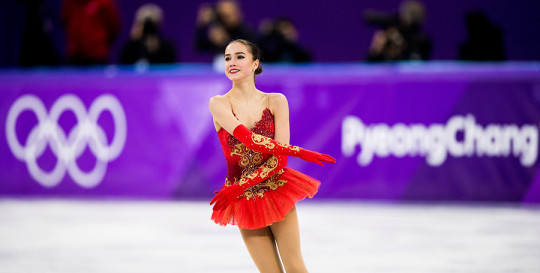
Video Link: https://www.youtube.com/watch?v=JEtYYtwX1sM
Introduction
Figure Skating is a sport in which single athletes or teams of athletes conduct artistic performances on ice. Both men and women participate in their own singles events with pair skating events and ice dancing events open to both genders (usually one male and one female).
Athletes produce a wide variety of moves in order to impress a panel of judges, who score the athletes based on their grace, flair and control. Moves include jumps and spirals in the air, spins on the ice and a number of different step sequences.
Figure Skating has been a part of the Winter Olympics since the games first began in 1924, and also made appearances at 1908 and 1920 Summer Olympics before that.
The United States are the current world leaders in Olympic Figure Skating, holding a total of 49 medals overall. Russia and Austria are the closest rivals with 26 and 20 medals, respectively. The Soviet Union also picked up 24 medals during their time in the competition.
Court Dimension
Figure Skating Winter Olympics 2018 was held at the Gangneung Ice Arena in Gangneung, South Korea. Figure Skating Rinks have a total area of 18,707 ft2 (1738 m2), with an average length of 196.85’ (60 m) and a width of 98.43’ (30 m). Hence, its corners have a circumference of 27.89’. (8.5 m).
Equipment
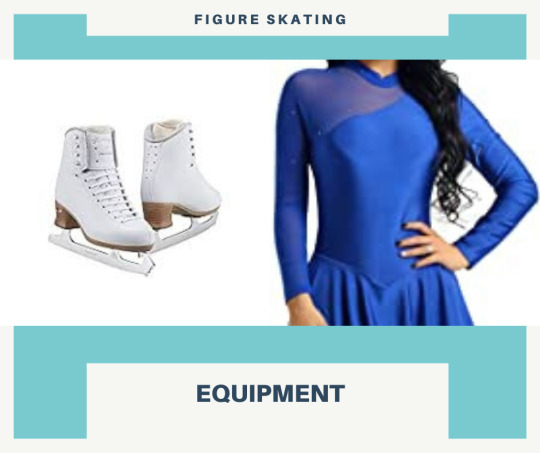
Costume - The figure skating costume should be made of light and elastic materials, as a rule, these are stretch fabrics. The costume of the figure skater reflects the style of the program and the music.
Figure Skates - Professional skates for figure skating are made of thick durable leather, have a long lacing and a large tongue. For professional skaters, skates are made individually. The blades are made of carbon steel and consist of two parts. The curved rocker for a good glide on ice. The toe part has teeth, for the execution of jumps and some elements of the program.
Basic Skills
Turns - Figure skating turns are an important part of the sport. Some turns are part of the basics and others are advanced and difficult to perform. Figure skating turns are important because they are part of the advanced figure skating moves. For example the entrance to certain jumps includes a three turn or a mohawk.
Steps - Figure skating steps a skills that when put together form what is called a footwork sequence. Some figure skating steps are variations on or combinations of turns. Power three turns, twizzles, and running threes are example
Spins - Spins in figure skating are often the most fun for the skater and most appealing to the figure skating audience. Crowds love to watch an elegant or super fast spin. There is so much important information related of figure skating spins that we have an entire section devoted to these figure skating skills. This section includes descriptions, pictures, and video demonstrations of figure skating spins.
Jumps - Jumps are spins in the air. Actually a jump is a back spin in the air. These figure skating skills have become one of the most important aspects of the sport since the creation of the international judging system. Triple and quad jumps receive so many points that they overshadow most of the other skills when competing. Some of the most elegant skaters have lost in competitions because another skater executes a series of point grabbing jumps
Spirals - Spirals are glides with one leg way up in the air. There are many variations of these figure skating skills. The first figure skating spiral learned is usually the arabesque. Skaters will then learn a catch foot variation. Important aspects for figure skating spirals are good extension, get the free leg extended high in the air, and moving steadily across the ice. A change of edge during a spiral will receive extra points
Moves in the field - Really moves on the ice not in a field! They are in some ways a replacement for "figures". The moves tests are intended teach the skater the skills they need to excel in the sport.
Technical and Tactical Skills of each team
Most individuals showed their different choreographed figure skating performance. Each figure skaters from different countries were such fascinating to watch and most of their performances are masterpiece. Let’s start with Russia (Alina Zagitova), she gracefully executed her performance through combinations just like double axel-triple toe and triple lutz-triple toe. She really had a flexible body which benefits her in her technical and tactical skills which helped her get the victory of the event. Next is from Russia (Evgenia Medvedeva), She performed with different varieties of movements which made her performance stunning, she had jumps and spins that results as an extraordinary performance. Next is from Canada (Kaetlyn Osmond), she has done such combos like triple-triple combos. She performed with a fast pacing combined with turns and jumps which made her performance eager to watch. Next is from Japan (Satoko Miyahara), watching her performance, she had leaps and jump variations that leads to triple toe loop. She showcased also spiral movements that makes the audience enjoy her performance. Next is from Japan (Kaori Sakamoto), her performance was really jaw dropping because of her splendid production. She has done such unique movements which made her almost got a high score to the judges. Next is from Italy (Carolina Kostner), She did a magnificent move in the field, spirals and jumps which made her performance opulent to the eyes, I can really say that she went through a lot failures in her practices because she showcased such a hard performance which I can really say that all her practices were really worth it. Next is from Canada (Gabrielle Daleman), I can notice in her tactics in presenting her performance is through mostly jumps and such spirals, resulting her performance with such superb presentation. Next is from South Korea (Choi Da-bin), she started her performance with a move in the field, she had jumps and turns in her way of her tactics. Next is from United States (Mirai Nagasu), she is such a skillful figure skater because of her performance with such impressive spins and jumps. She had points from the judges with her layback spin because it was really a hard thing to do which shocked most of the people and also me. Next is from United States (Karen Chen), she had tactics like toe jumps and lutz. She presented great progression of moves in the field and spirals which made her performance imposing. Next is from United States (Bradie Tennel), she showed tremendous jumps and spirals which is her tactics in the event. Next is from Russia (Maria Sotskova), Most of her tactics are spiral jump and moves around the field and gliding throughout her performance. Next is from Slovakia (Nicole Rajicova), her tactics were done through leaps, turns, spirals and jump. She showed an organized performance which I can really say that she really mastered her movement all throughout her performance because of her body language being showed in the performance. Next is from Germany (Nicole Schott), Her performance was spectacular to watch because she really moves gracefully and her movement has timing towards the music. Next is from Kazakhstan (Elizabet Tursynbayeva), extraordinary spirals, jumps, spins, steps turns were all present in her performance which is her tactics in the event. Next is from Australia (Kailani Craine), she was really energetic in her performance which helped her execute such stunning jumps, spirals and spins. She really enjoyed her performance. Next is from Brazil (Isadora Williams), her performance was having the tactics of different combos of spins and jumps combining with the music to result a spectacular performance. Next is from Finland (Emmi Peltonen), she had showcased jumps and spins that can really prove that she really mastered it well and has a unique ability that is not present to other players. Next is from Switzerland (Alexia Paganini), her tactics was done through spins and jumps from what I observe in her performance, she really mastered these two in order to add opulent view in the eyes of the audience. Next is from Belgium (Loena Hendrickx), her tactics in the event was through her strength in spinning and the combined with jumps to make her performance stunning. Next is from Hungary (Ivett Toth), she showed tactics of being classic, she wore a costume with a very simple design emphasizing her passion or theme of being punk and being classic. Next is from Latvia (Diana Nikitina), her way of presenting his performance was through spins, she mostly showcased this skill with a unique kind of way of executing it and that’s her tactics in the event. Next is from Sweden (Anita Ostlund), she has done a tremendous performance with her tactics of upright spin, this spin is really hard because you really need to have lower strength in order to perform this which results toa plus points to then judge scorecard. Next is from Kazakhstan (Aiza Mambekova), her tactics was through her hands, to add more joy in her performance. Lastly, is from Ukraine (Anna Khnychenkova), her tactics was through skating with one leg only. She had also executed such upright spin reaching her toes which made her performance outstanding.
Rules of the Game
Players & Equipment
Figure skating is a sport in which both men and women compete, and the only equipment needed is a pair of specially designed skates known as “Figure Skates.”
Figure Skates
Figure Skates are specially designed skating shoes with thick steel blades at the base and jagged grooves at the front known as “toe picks” – which assist athletes with their footwork on the ice, as well as landing and spinning. The specific style of toe picks can vary.
The key blades are usually about 4 millimeters wide, although this varies depending on the athlete’s foot style. They also have a small bend on one side to help with ice turns.
Figure skaters will often want to skate on the outer tips of their wheels. In order to accommodate step-work rather than skipping, ice dancers normally have slightly narrower blades on the base of their shoes, with a slightly different shape.
Costumes
In order to perform on a professional level, all men and women must wear special costumes. Men are expected to wear pants, while women must wear skirts and tights, trousers, or neon spandex.
Scoring
Figure skaters are judged by a jury of judges who use the ISU Judging System to rate them (usually nine judges including a technical inspector, and also a referee). This system works by giving varying numbers of points to competitors with different kinds of movements, as well as how quickly and successfully they are performed. A Grade of Execution (GoE) is measured, followed by a Scale of Success (SOP). A Grade of Execution (GoE) is measured, and this grade is then converted into an overall mark using a Scale of Value Table.
Ability, footwork, performance, perception, overall execution, choreography, and timing are the key factors scored during a normal Figure Skating performance. The more complicated maneuvers are often awarded the highest scores if they are done correctly. For example, the more rotations in a leap, the higher the score.
Winning
The athlete or team with the highest total score wins a Figure Skating competition.
Figure Skating Rules
Figure skaters must make their results interesting. According to the Zayak Rule, no participant can try triple or quadruple jumps more than twice.
If participants may not follow the rules and regulations for music and costumes, judges can penalize them or disqualify them entirely. Certain forms of music are forbidden, and costumes must be free of “excessive decoration” or be too revealing.
Time penalties will also result in athletes being disqualified.
How to officiate the sport
Officiating officials are the backbone of Figure Skating, ensuring fair competition for all skaters by enforcing the rules and regulations that govern the sport of figure skating.
Accountants
Accountants are also responsible for providing the judges, referees and technical panel officials with documents for recording their decisions. The accountants are also responsible for ensuring that the scoring software is set up properly, the scores are entered accurately and the results are calculated correctly.
Announcers
Announcers are responsible for announcing competitors before they perform at a competition. Announcers might also be asked to announce scores, names of officials and other general competition information as necessary. As the voice of an event, announcers need to be able to work as part of a team and have the ability to communicate effectively with competition hosts, referees and other officials.
Ice Technicians
Ice technicians are utilized at certain qualifying and international competitions to ensure the safety and quality of the ice surface. Primarily utilized at large competitions, the ice technician is the go-between for the event referee and arena personnel, and ensures each event runs safely and smoothly.
Judges
There are 2 types of Judges: Test Judges & Competition Judges
Test Judges: who can judge test sessions and nonqualifying competitions
Competition Judges: who can judge nonqualifying and qualifying competitions
Music Technicians
Music officials are responsible for the setup, tear down and operation of the equipment used to play music at competitions.
Referees
Referees are the designated leaders and spokespeople for an event. They also manage the panel of judges and, depending on the size of the competition, may serve as one of the event's judges as well.
Summarization
Everyone did well in the event, however Alina Zagitova from Russia got the victory with the score of 82.92. Second place is Evgenia Medvedeva also from Russia with a score of 81.61 and third place is from Canada named Kaetlyn Osmond with a score of 78.87. Watching the figure skating event was really fun and at the same time jaw-dropping because of the extraordinary performance of the players. I can really say that figure skating is not an easy sport, it requires determination to improve and will go though different failures in order to grow as a figure skater. I really respect those players since they really tried their best to win.
References:
Figure Skating. (n.d.). Retrieved from Sportwiki: https://sport-wiki.org/sports/figure-skating/#Equipment_for_figure_skating
The Basics. (n.d.). Retrieved from Go Figure Skating: http://gofigureskating.com/skills/index.html
Officiate. (n.d.). Retrieved from US Figure Skating: https://www.usfigureskating.org/support/officiate
Figure Skating Rules. (n.d.). Retrieved from Rules of Sport: https://www.rulesofsport.com/sports/figure-skating.html
2 notes
·
View notes
Text
A SPORTS BLOG: Artistic Swimming - Full Team Event from Rio 2016
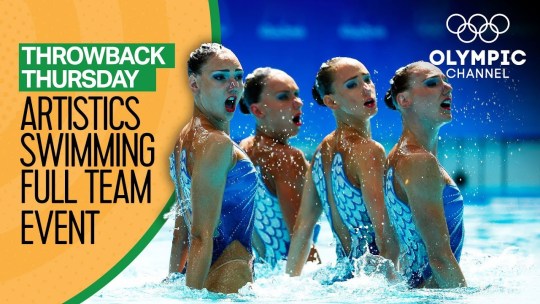
Video Link: https://www.youtube.com/watch?v=dRGQDubSAqw
Introduction
Synchronized swimming, also called water ballet, exhibition swimming in which the movements of one or more swimmers are synchronized with a musical accompaniment. Because of a similarity to dance, it is sometimes called water ballet, especially in theatrical situations. The sport developed in the United States in the 1930s. Synchronized swimming is an organized amateur sport in many areas of the world under the general supervision of the Fédération Internationale de Natation Amateur (FINA; International Amateur Swimming Federation), which publishes a list of stunts (movements or figures) accepted in competition. The FINA recognized synchronized swimming in 1954. Swimmers in solo, duet, or team (four to eight persons) competition perform several required stunts together with several of their own choice. At the Olympics and in world competition, they are scored by two panels of five judges on execution and style, both of the individual stunts and of their musical routine as a whole.
Court Dimensions

P.S: In artistic swimming, there is no lane ropes.
An artistic swimming or synchronized swimming is mostly done in an Olympic size pool which has the dimensions of 50 meters long, 25 meters wide, and a minimum of 2 meters deep.
Equipment
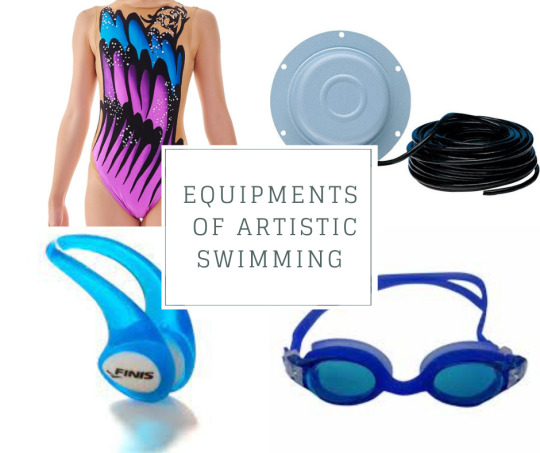
Nose Clip
In synchronized swimming, the athletes have to perform a lot of underwater movements. There are chances of water entering into the nose of the players. In order to avoid that, the athletes use a small clip of hard plastic or wire. It also has a thin rubber coating.
Goggles
Goggles provide safety to the eyes. Due to underwater movement, water may enter in the eyes. It is important to note that the goggles are not allowed for routine competitions.
Athletes can use goggles only for trainings. This is only used for figure test. Like goggles, athletes also cannot use the bathing caps during routine competitions. During figure test, only a white or black bathing cap is worn by athletes.
Underwater Speakers
The most important equipment for synchronized swimming is the underwater speakers. Swimmers cannot perform under water if the music is not audible. Music plays an important role in synchronized swimming because it is a rhythmic sport.
Swimsuit
One of the most important aspects of the swimsuit is that it must be comfortable for the athletes and it must be non-transparent. During the figure test, a black swimsuit is recommended for the athletes and during routine competition, a routine suit for each athlete that suits the music is recommended.
Basic Skills
Sculls - These are hand movements used to propel the body and are essential to synchronised swimming. Some commonly used sculls are support, standard, torpedo, split-arm, barrel and paddle scull. The support scull is most often used and is made up of two repeated movements. You need to hold your upper arms against your body and your forearms at 90-degree angles. Then, you move your forearms back and forth to create enough water pressure to hold your legs above the water.
Eggbeater - This move is much like how a manual eggbeater works, with one leg rotating in a clockwise manner and rotating the other leg in an anti-clockwise manner. Synchronised swimmers use this kick because it leaves their hands free to perform strokes. Due to the opposite motion of the kick, it is a stable and efficient way for swimmers to attain the necessary height to perform moves above the water.
Positions – There are hundreds of positions that can be used to create infinite combinations. There are 6 most common positions that are used such as:
Crane Position - Hold your body in a vertical position with one leg held vertically above the water surface, while the other leg is held parallel under the surface in a 90-degree angle or "L" shape.
Ballet Leg Double Position - From lying flat on the water surface, draw your knees towards your chest with shins parallel to the water surface. Straighten your legs above the water surface to assume a Surface Ballet Leg Double position.
Side Fishtail Position - This is a position similar to the crane. One leg remains vertical, while the other is extended to the side parallel to the water, creating a side "Y" position.
Knight Position -The body is held vertically with your head in line with the hips and pointed to the bottom of the pool. One leg is lowered to create a vertical line perpendicular to the surface.
Flamingo Position - Similar to the ballet leg position where the bottom leg is pulled into the chest so that the shin of the bottom leg is touching the knee of the vertical leg.
Split Position - With the body vertical, one leg is stretched forward along the surface and the other leg is extended back along the surface.
Lifts - These are formations that are formed underwater and as swimmers propel themselves towards the surface, they stay in formation and add more elements like acrobatics. There are three parts to a lift in synchronized swimming such as:
The Flyer - Flyers are agile and flexible and are usually the smallest member of the team. It is preferable that they have a gymnastics background as they need to perform complicated moves while on the top of the formation.
The Base - Base swimmers tends to be small in size, but should have good leg strength and a solid core as they make up the structure of the formation.
The Pushers - Pushers are the bigger and stronger swimmers because they need the strength to propel the formation to the water surface.
There are also 2 types of lifts and these are:
The Platform Lift - The base lays out in a back layout position underwater, where they lie on their back to form a platform of interlinked bodies. The Flyer sets in a squatting position and stands once the lift reaches the surface. The remaining teammates use the eggbeater kicks to hold the platform and the flyer out of the water.
The Stack Lift - Considered to be an updated version of the Platform, the Stack Lift begins with the base squatting while underwater, supported by the pushers. The flyer then stands on the shoulders of the base. The pushers and base gradually stretch out their limbs, elevating the flyer. A rotating descent is usually added to this lift.
Technical and Tactical Skills of each team
Most of the team showed the same skills as they were all well-trained synchronized swimmers, what only differ from each team is on how they performed and the unique movements of each team to create such spectacular movements to engage and attract the attention of the audience. These representing teams such as Egypt, Australia, Italy, Brazil, Russian Federation, Ukraine, People’s Republic of China, and Japan showcased jaw-dropping performances. Talking about Egypt, they had organized flips and turns to have a transition to their formations. In team Australia, they showed great energy with their formations making the battle between the different competitors hard to judge. In team Brazil, they manifested such eye-opener start through their graceful turns and flips with different transitions. Speaking of Team Italy, they’ve showcased a theme of seasons and somewhat showed a marvelous formation to make the audience appreciate their performance and at the same time attract the judges. For team Japan, they had astonishing formations and patterns in moving to different formations and they did such remarkable lifts and positions. Talking about the team Ukraine, they started it off with outstanding formations and expressing their feelings through their movements which made them perform such a thrilling performance. For team China, they made an intro with a strong synchronized flip and had splendid succession all throughout their performance. Last but not the least, talking about the tactics of team Russia that got the gold medal, they performed through the beat of the song making their movements coordinate through it and they really danced their heart out making them enjoy their performance that results to an extraordinary and memorable performance which shocked the judges.
Rules of the Game
No Touching The Bottom
One of the things which makes the lifts all the more impressive is that artistic swimmers are not allowed to touch the bottom of the pool at any point during their routines.
No Bling
Presentation is a unique and important part of artistic swimming but there are certain restrictions on what swimmers can wear. For example, artistic swimmers are not permitted jewelry, theatrical make-up, or inappropriate costumes.
No Goggles
Another restriction during artistic swimming routines is goggles. However, swimmers in figures competitions are permitted to wear them.
Team Means Team
Teams normally contain eight swimmers, but the minimum number for a team is four. Teams lose marks for every swimmer they have under the full complement because it is easier to synchronize the fewer people there are in a routine.
Stick To The Schedule
Routines can be anything from two and a half minutes to five minutes long, depending on whether they are performed alone or as part of a team. However, swimmers are penalized if they take 15 seconds fewer or longer than the specified time.
Scoring and judging
In the figures event, judges evaluate design and control. The design of a figure is determined by the accuracy of the positions and the correctness of the transitions between those positions. Control includes extension, height, stability, and an even tempo.
Routine judges are always evenly divided into two categories. For free routines, half of them judge artistic impression and the other half judge technical merit. For technical routines, judges evaluate the performance based on execution and overall impression.
Artistic impression judges consider choreography, interpretation of music, and manner of presentation. Manner of presentation is evaluated on the appearance of capability and effortlessness. Technical merit judges evaluate execution, synchronization and the amount of difficulty.
After all of the judges submit their routine scores, the high and low numbers are dropped. Then, the scores from each category are added together get the composite score. At some competitions, medals are awarded for technical routines and free routines, but usually both scores are combined for the final ranking.
How to officiate the sport
There are different officials assigned during the artistic competition to officiate the sport and these are:
Timekeeper
The role of a timekeeper is to check, and record, the overall times of the routines and of the deck movements. If the time limit for the deck work is exceeded or there is a deviation from the permitted routine time allowance, the timekeeper advises the referee.
Clerk of the course
The role of a clerk of the course is to organise the competitors so that they are ready for their events at the required time. During figure competitions, they ensure that the swimmers are in the correct order to perform their figures.
Scorer
The role of a synchro scorer is to record marks from the judges and make the necessary computations for each routine.
Judge
Synchro judges are essential for running synchronised swimming competitions as they provide scores based on the performance of each routine. They are also responsible for marking grade level assessments. To reduce the level of subjectivity in scoring, all synchro judges must be expertly-trained. They require a full understanding of FINA and the ASA’s rules and regulations for synchronised swimming competitions.
Referee
The role of a synchro referee is to oversee the control of a synchronised swimming competition. The referee makes sure all aspects of the event are run smoothly and follow FINA rules.
Summarization:
All of the teams showcased such splendid performance and different ways on how they perform depending on their theme. I really look up to them as I can really say that they really had so much time in preparing for the competition. I can really imagine how hard they went through just to present those kinds of imposing performances. Thinking about being underwater is much hard as well as tightening your core just to make your body float in the water. This sport is not easy and will never be easy because it really requires such determination and the will to learn and to improve. Out of all the teams, one should always bring the bacon and that is TEAM RUSSIA. They really deserve being the champion as they really showed marvelous positions and formations resulting to the appeal of the eyes of the audience which also gave a plus point in their scorecard.
References:
Tutorials Point. (n.d.). Retrieved from Tutorials Point: https://www.tutorialspoint.com/synchronized_swimming/synchronized_swimming_equipment.htm
Swim England Artistic Swimming. (n.d.). Retrieved from Swimming: https://www.swimming.org/artistic-swimming/introduction-to-artistic-swimming/
Synchronized Swimming Rules & Regulations. (n.d.). Retrieved from SwimOutlet: https://www.swimoutlet.com/guides/synchronized-swimming-rules-regulations
Officials in synchro. (n.d.). Retrieved from Officials in synchro: http://edinburghsynchro.co.uk/officials-in-synchro/
Synchronized Swimming Pool Dimensions. (n.d.). Retrieved from Swim Outlet: https://www.swimoutlet.com/guides/synchronized-swimming-pool-dimensions#:~:text=The%20pool%20must%20be%20at%20least%2020m%20wide%20x%2030m,distance%20of%208m%20or%20less.
1 note
·
View note
Text
A SPORTS BLOG: Monica Puig (PUR) vs Angelique Kerber (GER): Women’s Tennis Singles Final

Video Link: https://www.youtube.com/watch?v=5-iONJOk4NM
Introduction:
Tennis is a racket sport that can be played individually against a single opponent or between two teams of two players each. Each player uses a tennis racket that is strung with cord to strike a hollow rubber ball covered with felt over or around a net and into the opponent's court.
Court Dimensions:
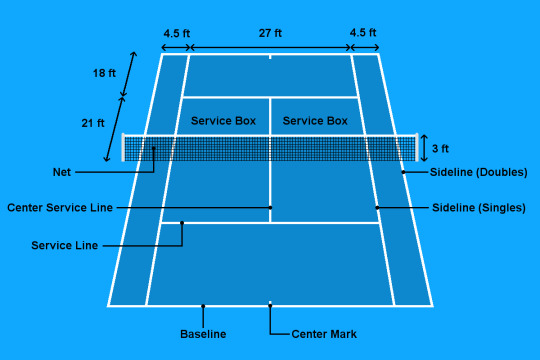
The 2016 Olympic Games in Rio de Janeiro was held in Rio de Janeiro, Brazil. Specifically in the Barra Olympic Park.
A tennis court is 78ft (23.77m) in length and 27ft (8.23m) in width, with the service line being 6.4m from the net. A singles court has a total playing area of 195.65m². The court is divided into two equal areas by a net suspended by a cord or metal cable attached to two net posts. The net is 1.07m high and is fully extended to fill the space between the two nets posts. The net is 0.914m high at the center, held down tightly by a white strap. A white band covers the cord or metal cable and the top of the net. For singles matches, the net posts’ centers are 0.914m outside the singles court on each side.
The lines at the end of the court are baselines, and the lines at the sides of the court are sidelines. The baseline is up to 8m wide. Service lines are two lines between the singles sidelines, 6.40m from each side of the net, parallel with the net. On each side of the net, the area between the service line and the net is divided into two equal parts called the service courts. The line dividing the service courts is the center service line and is drawn parallel with the singles sidelines and halfway between them. The center service line is 4.11m wide.
Equipment
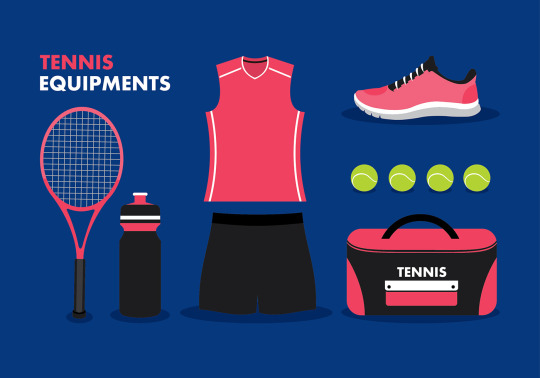
· Headband – It helps organize the hair of the player and to stop sweat from moving towards the face.
· Cap – It is a headwear that helps you prevent from not being able to see the opponent due to direct sunlight.
· Racket – It is a bat with a long handle attached to a circular frame covered in a network of tight strings; used to strike the ball.
· Uniform - Most players usually wear a shirt. If you wear a sleeved or sleeveless cotton blend top, you will feel cooler and more relaxed. However, some courts do not sanction sleeveless shirts, so double-check their policies first.
· Water Bottle – It is where you can store your water to prevent from being dehydrated.
· Shoes – It is sports shoe with a rubber bottom and a leather or hard cotton top that is ideal for tennis sport.
·Tennis Balls – It is wrapped in a fibrous felt that alters their aerodynamic properties, and each is adorned with a white curvilinear oval.
· Bag – It is a bag used to transport a player’s tennis rackets.
Basic Skills
Footwork
Although you’re not traveling a far distance to the naked eye, tennis players actually rack up miles of walking and running throughout the course of a match. Endurance is key, but so is your footwork because there are tons of quick movements that you need to make in a short period of time and over a short distance.
Serving
This is a crucial part of the game because if you’re not able to effectively serve a tennis ball, it’ll be hard to take control of any game or match you’re participating in. The actual act of serving a ball takes but a few seconds. However, there are tons of small movements within the act itself that make up a successful experience with honing this skill. These small movements include mastering the ball toss, gaining a consistent point of contact, and properly timing each of your movements.
Forehand and Backhand Strokes
There are a number of different strokes used during a tennis match, but forehand and backhand strokes are easily the most common. Learning how your body responds to the backswing, the point of contact, and the follow-through of each stroke is crucial before going on and learning anything else.
Shots:
Serve – It is what players begin every single shot in a tennis match. While one player is serving, the other is receiving, and they take turns after the end of every game. Serves can take different shapes and forms, but they are generally characterized by a movement where the player swings the racket above his head, while still standing behind the baseline.
Return - It is a shot where one player waits to see where the other player’s serve lands and then attempts to hit the ball back to the other side. A return can be executed in several different ways, with a forehand, backhand, slice, block, or chip. The most important aspect of a return is just getting the ball back to the other side, no matter how.
Forehand – It is for the vast majority of players, their strongest weapon. A player hits a forehand when he allows the ball to bounce once on his court before hitting it, and hits it with his dominant side. With very few exceptions, players hit forehands using only one arm.
Backhand - It is another one of the main shots in a tennis game. It is the equivalent of the forehand but executed on the player’s non-dominant side. For instance, if a player is right-handed, the backhand will be executed on the left side. If a player is left-handed, the backhand will be executed on the right side.
Slice – It is essentially a variation of the backhand shot. Instead of hitting the ball on the top, your racquet swings through the bottom of the ball. That adds underspin to the shot, so after the ball bounces on the other side, it stays low and close to the ground.
Forehand volley - It is a fairly simple movement, in which you use only one arm to hit a ball by your dominant side, without letting the ball touch the ground. It requires firm hands and fast reflexes.
Backhand volley - It looks a lot like a backhand slice, but without letting the ball touch the ground. Once again, a volley usually occurs when you are standing close to the net. A backhand volley always happens on your non-dominant side.
Overhead - It is the last basic shot you should become comfortable with is the overhead (also called smash in some countries). You must be standing close to the net and hit the ball without bouncing. You need to hit the ball over your head (similarly to a serve), and that is why this shot is named the way it is.
Technical and Tactical Skills
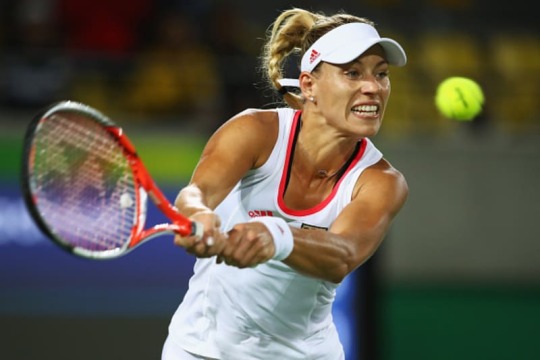
Talking about Angelique Kerber, she really tried her best in portraying a good tennis player. She showcased such strategies and skills that helped her fight all throughout the game such as having a tremendous return, slice and backhand volley. Kerber’s return is somewhat astonishing because of her unique ability to react towards the rally between the two opponents. Another is her slice, she really executes it well hitting the racquet through the bottom of the ball that helped her have an underspin shot and when usually the opponent hits the ball in an easy manner, Keber uses her backhand volley when running towards the net.

On the other hand, Monica Puig has showcased such beautiful performance, from her skills, abilities, decision-making and etc. Monica Puig was really dominating the game due to her wise technical and tactical skills. She commonly uses shots such as overheads, backhand and forehand shots and her serve. Monica’s ability through her overhead shots helped her dominate the game as she has right timing using this shot. Monica’s forehand and backhand shots are also captivating as she performs it like she had been practicing it for how many years since you can really observe the both her backhand and forehand are executed smoothly and has the right power depending on her strategy to drain the opponent. She really is a praiseworthy player since she really tried her best to have a wonderful performance. Winning her gold medal made her the first Olympic gold medalist in her country.
Rules of the game
Who Serves First
Usually the age old question of who serves first is settled by a simple coin toss. The person who wins the coin toss may elect to serve first or select a side of the court which he would like to receive his opponents serve.
The server will continue serving the ball to the receiver until the set has ended. After the set has ended, the receiver will become the server and serve the ball until the next set has ended. This process is repeated throughout the match.
Fault and Double Fault
The server is given two opportunities to serve the ball within the service court as marked in the diagram below. When the server fails to get his first serve into the diagonally opposite service court, it is called a fault serve. A double fault is committed if the server fails to get his second serve into the diagonally opposite service court and the receiver will then earn a point.
If the ball hits the net and falls within the service court, this is called a “net serve”, the server will be entitled to re-serve the ball into the service court. For example, if a “net serve” is made on the server’s first serve, the server will be entitled to re-serve his first serve. There are no limits to the number of “net serves” a player can commit.
The server should stand before the right side of the baseline and serve the ball diagonally across to the receiver’s right service court and then proceed to serve from his left side of the baseline diagonally across to the receiver’s left service court.
Counting Scores
Counting score in tennis match is some tricky business. The server’s score is always announced first before the receiver’s throughout the game.
The point system of a tennis match is as follows:
• No points are scored = Love
• 1 point scored = 15 points
• 2 points scored = 30 points
• 3 points scored = 40 points
• 4 points earned = set point (set over)
For a tennis player to win a game, he/she must win with at least a two point lead.
If the score is tied at 40 to 40 (what is called as a “Deuce”), a player must earn two consecutive points (an “Advantage” point and “Point”) to win the game. If the player who has an “Advantage” point loses the next point, the score will be “Deuce” once again.
A set is won when a player has won a minimum of six games with a two game advantage over his opponent.
In or Out
In a game of singles, the ball must be hit within both “SERVICE COURTS”, the “BACK COURT” and the “ALLEY LINE” as marked in the diagram below for a point to be scored. Balls hit in the between the “SIDE LINE” and “ALLEY LINE” are considered balls hit out of court and thus earning your opponent a point.
In a doubles game, the ball must be hit within both “SERVICE COURTS”, the “BACK COURT” and the area between the “ALLEY LINE” and “SIDE LINE” for a point to be scored.
How to officiate the sport
Chair Umpire:
The chair umpire is the person sitting in the highchair at the side of the court officiating over all decisions made out on court with the power to over rule any judgements made by lines persons or indeed players themselves. They are the ones keeping track of the score and more recently the amount of challenges each player has left to call upon. Basically, out on court, the buck stops with them. They vocalise the score after every point and in between games. They complete the scorecard as the match progresses and they maintain order throughout. They keep the audience quiet and make sure they follow the rules of spectator etiquette. If a player has any queries then they are the first stop of call and often the final decision maker. They ensure players adhere to time constraints and acceptable behaviour on court. They have the ability to award code violations to players amounting to warnings, the loss of points, games and even matches. There is only ever one chair umpire per match played.
Line Umpire:
The line umpires are the officials who have the responsibility of calling the ball in or out during all calls and especially the close ones. They can be over ruled by the chair umpire but this rarely happens. There can be up to nine lines umpires on a court at any one time. Three at either end of the court looking after the side lines and the centre service line, one each judging the baseline and a final line umpire looking after the service line depending on who’s serving at the time. Nine is the maximum amount of line umpires on a court and in reality can vary from anywhere between two and nine.
Net Court Umpire:
The net court umpire is an umpire sitting at the net to call any ball that hit the net during service called a “net court” or “let”. If a ball hits the net during a serve then the server is asked to replay that shot again if the ball lands in or to play their next serve if it has landed out. If it was their second serve and the net court serve landed out then it is deemed to be a double fault and the next point is played. Most tournaments today no longer have this umpire as new technology has placed a sensor on the top of the net to detect any ball hitting the net and thus replacing the need for this type of umpire. Either that or the chair umpire will make the decision.
Ball Persons:
The ball persons are the ones that are essential to make the game run smoothly in terms of operations. There are usually six ball persons on a court to look after this job. There are two at the back of each side of the court and two more at the net, covering each side of it. Their job is to ensure that the server always has a choice of tennis balls to choose from before they start to serve. They change the balls after every nine tennis games and ensure that the players want for nothing. This might include new drinks, an umbrella in the sun, taking plastic covers from racquets or ensuring that they always have a towel to hand.
Referee:
the tournament referee is the person in charge of making all decisions regarding all the matches. They oversee the schedule of play and is the person assigning matches to specific courts. They make sure that all the ITF’s regulations are enforced including the conduct of all involved and must be present whenever any matches are being played. They can over rule chair umpires and in fact their decision is final. They are present at the draws and are responsible for allocating the seeding. They are the person who has the say in whether play is suspended on account of rain and must be available to resolve disputes regarding to tennis rules.
Summarization:
The match between the two skilled athletes was very exciting and thrilling. In every game, there will always be one player who will dominate the game and that is Monica Puig. Monica Puig obtained the gold medal as she knocked off Kerber with the scores 6-4, 4-6, 6-1. The game was very entertaining as the supporters of Puig was dressed in their country’s colors which gave confidence to Puig and all of her supporters boosted Puig’s confidence as they were cheering for her whole-heartedly. Monica Puig got the gold medal of the Rio 2016 and was known for the saying “ The underdog who became a champion”.
References and Photo Credits:
Tennis Court Dimensions & Size. (2020, March 27). Retrieved from Harrod Sport: https://www.harrodsport.com/advice-and-guides/tennis-court-dimensions
Basic rules of tennis. (n.d.). Retrieved from Active SG: https://www.myactivesg.com/Sports/Tennis/How-To-Play/Tennis-Rules/Basic-rules-of-tennis#:~:text=For%20a%20tennis%20player%20to,%E2%80%9D)%20to%20win%20the%20game.
Tenniswithalan. (2013, 26 August). Officials at a tennis match. Retrieved from Bounce Tennis Academy: https://bouncetennis.wordpress.com/2013/08/26/officials-at-a-tennis-match/#:~:text=The%20line%20umpires%20are%20the,court%20at%20any%20one%20time.
The 8 Basic Tennis Shots & Skills (Explained). (n.d.). Retrieved from My Tennis HQ: https://mytennishq.com/the-8-basic-tennis-shots-skills-explained/
Adidas Tennis Camps. (2020, January 27). Retrieved from Tennis Camper: https://tenniscamper.com/3-tennis-skills-all-beginners-need-to-master%EF%BB%BF/
https://tennismash.com/2016/08/14/gallery-womens-gold-medal-match/gold-gall-09/
https://tokyo2020.org/en/news/classic-finals-the-underdog-who-became-a-champion
https://bleacherreport.com/articles/2657559-monica-puig-vs-angelique-kerber-olympic-tennis-womens-final-score-reaction
https://tennis-uni.com/en/tennis-court/
https://www.vecteezy.com/vector-art/137382-tennis-equipment-free-vector
1 note
·
View note
Text
A SPORTS BLOG: Rio Olympics 2016 Men's Singles Table Tennis
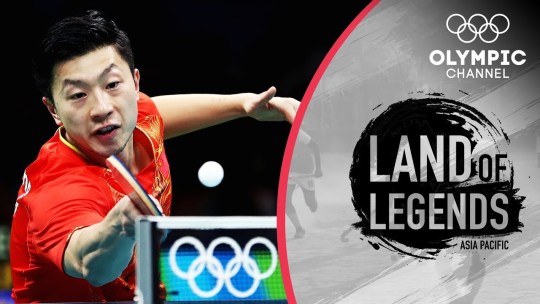
Video Link: https://www.youtube.com/watch?v=F5H-Eq_Kcxw
Introduction
Table tennis is also known as ping-pong, is a sport in which two or four players hit a lightweight ball, also known as the ping-pong ball, back and forth across a table using small rackets. The game takes place on a hard table divided by a net. Players must allow a ball played toward them to bounce one time on their side of the table and must return it so that it bounces on the opposite side at least once. A point is scored when a player fails to return the ball within the rules. Play is fast and demands quick reactions. Spinning the ball alters its trajectory and limits an opponent's options, giving the hitter a great advantage.
Court Dimensions
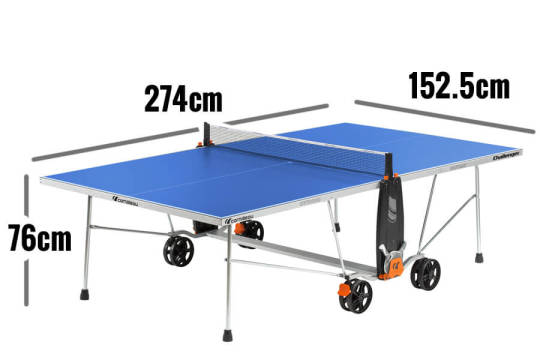
The game was held in August 11, 2016 at the third pavilion of Riocentro Exhibition and Convention Center located at Rio de Janeiro.
For a full-size table tennis table, the upper surface is called the playing surface. It requests a certain elasticity and good bounce of a ping pong ball. The dimensions of a full table tennis table size are 274 centimeters long, 152.5 centimeters width, and 76 centimeters height measure from the ground.
Equipment
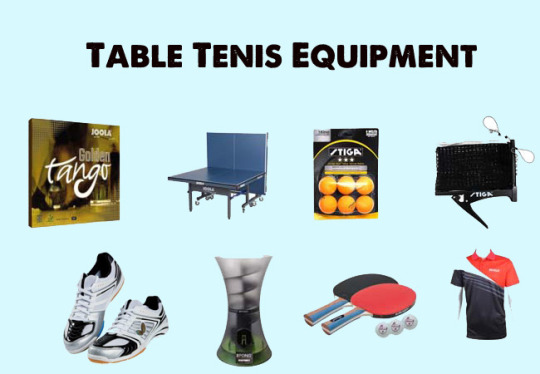
· Racket
· Ball
· Table
· Net & Post
· Uniform
· Shoes
Basic Skills
1. Stance and footwork - Before hitting your first shot it’s worth getting your body in the right position. A correct and stance in relation to the table depends to some degree on your grip, and whether you’re are attacking, defending, or serving the ball. However, even as your arm position and placement relative to the table changes, you should always have the correct stance and body posture. The right stance gives you the balance, stability, and range of movement you need to play the game.
2. Holding the paddle - Your hands and arms’ exact position in your stance depends on your grip or how you hold the bat. There are two basic grips in table tennis: the shake hand grip and the penhold grip. The different types of grip have specific variations for your hand position on the paddle, depending on your preference and style of play.
Each grip has advantages and disadvantages, but it’s also essential to choose the grip that is comfortable and natural for you. Once you have mastered an essential grip, you may want to learn more advanced grips to improve your game further and give you more options.
3. Serving - A table tennis’ serve is a very essential skill and it’s also a crucial skill since the service is the only time you have complete control of the ball and the game. There are many different types of serves, each with different pros and cons but the basics remain the same.
4. Strokes – It is a basic skill that a player should learn, since it is a skill that will help the player on the proper positioning of the racket and at the same time know the comfort racket position of a player. There are four basic table tennis strokes such as:
- Forehand drive - It is the most basic and fundamental ping pong stroke. It returns aggressive/attacking strokes and lands your ball close to the opponent’s baseline or sideline.
- Backhand drive – It is the mirror of the forehand drive, intended to return attacking shots and land the ball at the opponent’s baseline.
- Backhand push – It returns short balls, and prevents your opponent from making an attacking return.
- Forehand Push - It is also designed for returning short balls and preventing attacking shots.
Technical and Tactical Skills of each team
Both of the players showcased their best abilities especially in showing their tactical and technical skills. They both showed the basic strokes and such skills that a player should have, however what makes a player more advantage which can help them win the game varies in their quick decision skills and such reaction time and well-conditioned body. They both gave out their performance which made the game very remarkable. What I observed with their technical skills is they usually use these strokes such as forehand flick, backhand topspin close to the table, forehand push, backhand flick and used in serving is the backhand side-spin serve. Watching the game, I can really notice Ma Long showcasing different forehand specialty, he really proves his called nickname in table tennis the “Cannon Forehander”. They both showed fast reaction time, at the moment decision skills, instincts and fast footwork. Each player has different techniques in every rally of the game.
Rules of the game
Scoring and Games
Games are played to 11 points.
Players serve two serves each, alternating. A player does not have to win specifically off their own serve in order to win a point.
If a game ties at 10-10, a player must win by 2 points. In this situation, players serve one serve each, alternating.
If your hit bounces back over the net by itself it is your point.
An “edge” ball bouncing off the horizontal table top surface is good.
In competition, games are played best of 5 (first to win 3 games) or best of 7 (first to win 4 games). Social games can also be played best of 3 (first to win 2 games).
Legal Serving
The serve can land anywhere in the table.
You must throw the ball up straight, from a flat palm.
Your toss and service contact must be behind the table surface (not over).
You cannot hide the ball from the ball toss to contact, with any part of your body.
If the ball hits the net during service, it is a let, the point is replayed. There is no limit or point deductions for let serves.
Equipment Basics
A table tennis racket must be one side black, one side (recently approved) any approved color.
The official approved ball is the 40mm+ plastic ball.
The dimensions of an approved table tennis table are: 9ft long, 5ft wide, 2.5ft high
The approved height of a table tennis net is: 6 inches
Officiating the Sport
Referee
He/she decides any question of rule interpretation and ensures that the competition is conducted in accordance with the relevant laws and regulations.
Umpire
His/her primary duty is to decide the result of each rally.
Assistant Umpire
He/she takes over or shares some of the umpire’s duties and solely responsible for decisions on edge balls, and has the power to decide on the legality of the player’s service action.
Timekeeper
Monitor the duration of the practice, play in a game, intervals between games, and any authorized suspension of plays.
Stroke counter
His/she solely has to count the return strokes of the receiver.
Summarization
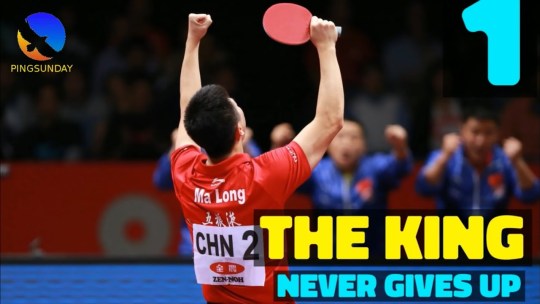
The battle between the two aspiring players in table tennis was mesmerizing as Ma Long finished the game strong having the score of each set: 14-12, 11-5, 11-4, 11-4. As Zhang Jike showed negative body language in the approaching last set which led to the leading of Ma Long with 3-0, it made Zhang Jike lose hope in the last set as Ma Long always takes the victory in every set. Ma Long is now known for its forehand strokes which people named him the “Cannon Forehander”.
References and Photo Credits:
Basic Table Tennis Skills You Need To Know. (n.d.). Retrieved March 11, 2021, from Pingpong Ruler: https://pingpongruler.com/basic-table-tennis-skills/
Rules of Table Tennis. (n.d.). Retrieved March 11, 2021, from Team USA: https://www.teamusa.org/usa-table-tennis/rules
Maribao, T. M. (2018, November 20). Officials of Table Tennis and their duties. Retrieved March 11, 2021, from Prezi: https://prezi.com/uuswuvndkebu/officials-of-table-tennis-and-their-duties/
https://pingsunday.com/top-5-reasons-why-china-is-so-good-at-table-tennis/
https://www.tabletennisspot.com/basic-types-of-table-tennis-equipment/
https://www.owo-7.xyz/products.aspx?cname=table+tennis+table+specs&cid=41
1 note
·
View note
Text
A SPORTS BLOG: Philippines vs Thailand Badminton Men’s Singles Quarterfinals Sea Games 2019
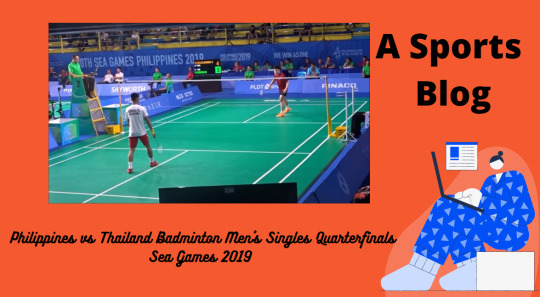
This is a badminton blog about the game between the Philippines vs Thailand Badminton Men’s Singles Quarterfinals Sea Games 2019.
Badminton originated in Asia, particularly India. It was known him with the name of Poona (an original city located in the western Indian state of Maharashtra).
It was taken to England by the officers of the British army around 1873. In 1890 it was implanted in the United States. And in 1895 the National Badminton Association of the United States was created, which was in charge of unifying the rules of the game.
Badminton consists of hitting the pen with the racket so that it crosses the track, over the net, and ends up in the opponent’s sector, managing to finish the point when the wheel touches the ground.
This sport combines the requirements of aerobic endurance, speed and strength. It is being a technical sport with a high level of coordination requirement. It also required to have great skill in the handling of the racket.
Court Dimension
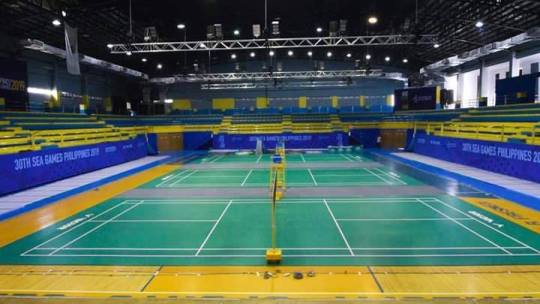
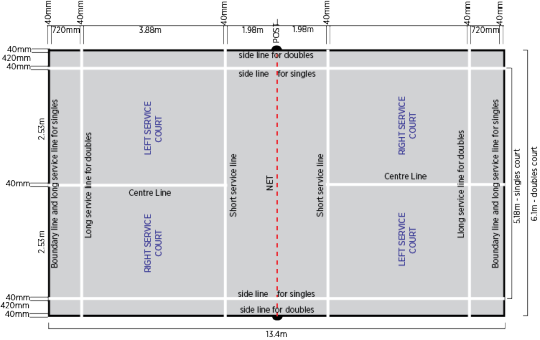
The badminton battle between Thailand vs Philippines took place at the Muntinlupa Sports Complex. The badminton court has a measurement of 13.4m long and 6.1m wide. For singles the court is marked 5.18m wide. The lines marking out the court are easily distinguishable and coloured white or yellow. The lines are 40mm wide. A court may be marked out for singles only. The back boundary lines also become the long service lines and the posts or the strips of material representing them are placed on the side lines. The diagonal full length of the full court is 14.366m.
Posts
The posts are 1.55m high from the surface of the court and remain vertical when the net is strained. The posts are placed on the double side lines irrespective of whether singles or doubles is played. The posts or supports must not extend into the court beyond the side lines. Where it is not practicable to have posts on the side lines, some method can be used to indicate the position of the side lines where they pass under the net by the use of thin posts or strips of material 40mm wide, fixed to the side lines and rising vertically to the net cord.
Net
The net is 760mm in depth and a minimum of 6.1m wide. The top of the net from the surface of the court is 1.524m at the center of the court and 1.55m over the side lines for doubles. There must be no gaps between the ends of the net and the posts. If necessary, the full depth of the net at the ends is tied to the posts.
Equipment
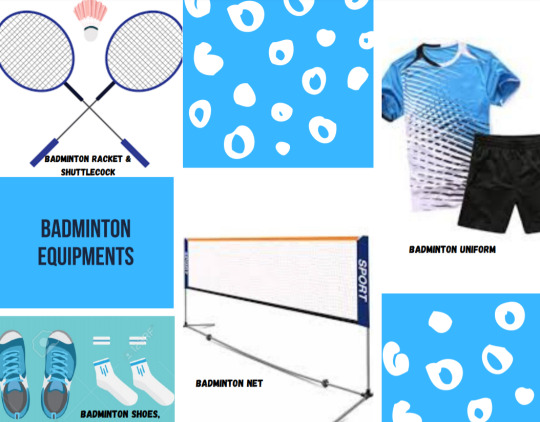
The equipment that was used by the players in the video was:
- Badminton Racket -is a sports implement consisting of a handled frame with an open hoop across which a network of strings or catgut is stretched tightly.
- Shuttlecock - is a high-drag projectile, with an open conical shape. The cone is formed from sixteen overlapping feathers embedded into a rounded cork base.
- Badminton Net - is the central gameplay element in a game of Badminton, requiring players to return the shuttlecock from one side of the court to the other during the match.
- Badminton Uniform – consists of comfortable shirts and shorts that don’t hinder your movement are ideal to play the sport. A cotton round-neck or collar shirts with a pair of light shorts are usually preferred
- Badminton Shoes - are lightweight with soles of rubber or similar high-grip, non-marking materials.
- Socks – is a garment for the foot and lower part of the leg, typically knitted from wool, cotton, or nylon.
- Badminton Wrist Band - is an encircling strip worn on the wrist or lower forearm, and it helps in preventing the sweat flowing to the handle of the racket.
Basic Skills
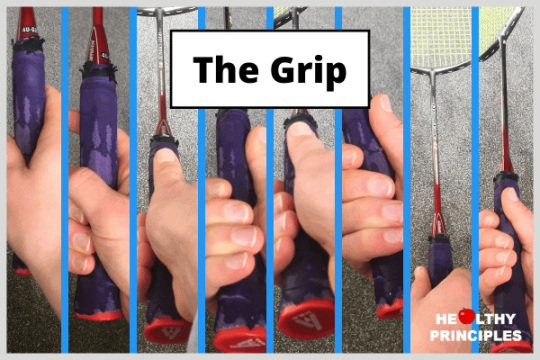
Grip – Having a proper grip in badminton is essential since the correct grip will allow you to have more control and will help you dictate where you place your shot.
There are numerous ways of holding a badminton racket depending on whether your shot is forehand or backhand.
These are the varieties that you could use:
//Forehand grip – anything on racket side, right – right-handed & left – left-handed; overarm or underarm.
//Backhand grip – anything to the non-racket side, left – right-handed & right – left-handed; overarm or underarm.
//Universal grip – a type of backhand grip where the thumb is on edge of the fatter face of grip, used for backhand clear and the like.
//Panhandle grip – the thumb and finger pinch the rocket’s top part to tap the coming shuttlecock.

Serve – This is a necessary skill that is needed to be mastered since having a good serve is like having a high tendency to get points and can give you advantages during the rally.
There are 2 types of Serve that is being used in badminton:
//High Serve – It is used when you want to force your opponent to run to the back of the court by hitting the shuttlecock toward the rear end of the court and having a good high serve will usually save you from receiving a smash from your opponent.
//Low serve – It is used to bring the opponent forward by hitting the shuttlecock toward the front of the court and it makes the opponent to dash forward and move under the shuttle to return it. This is one way for you to have a chance to have a smash or a net kill.
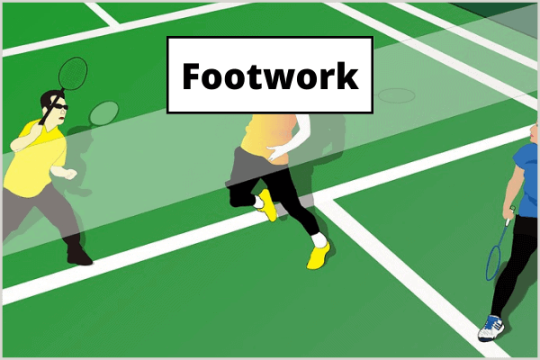
Footwork – It is a vital skill in badminton. It consists of stepping, crossover, stride, dogtrot, and jumping. Each set of footwork is generally started from the center of the court. It is arguably the essential skill in badminton because it allows players to move efficiently around the pitch while being able to meet and hit the shuttle with proper balance, timing, and technique.
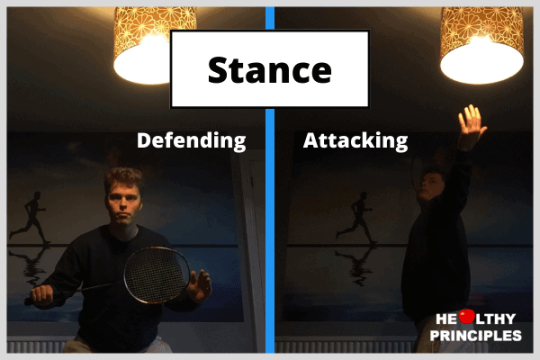
Stance – It is a way on how a player stands when retrieving individual shots from their opponent.
There are 3 basic stances in badminton:
//Defensive stance – This stance is used to defend opponent smashes.
//Attacking stance – This stance is effective in returning a high or short lift from the opponent.
//Net stance – This stance is used in returning the stroke from the opponent after sending a net shot.
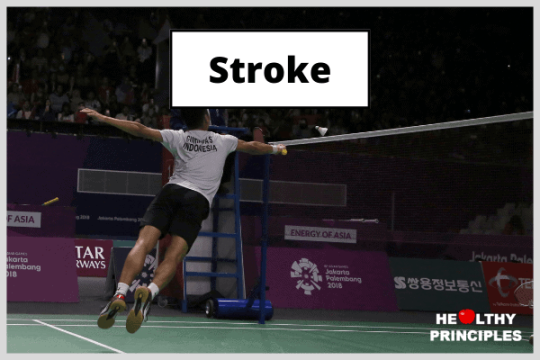
Stroke – It is a skill that a player needs to execute individual shots. This involves the swing motion of a player’s racket arm. Strokes are fundamental to becoming a good badminton player and executing superior shots. To categorize the strokes, there are two main kinds of strokes such as:
//Forehand shots – this type of stroke should be played when the shuttlecock is on your, the player’s, racket side. In this, the index finger will lead control of the forehand stroke as a player swings underarm or overarm. And to play, you swing the wrist along with the index finger as support.
//Backhand shots – this type of stroke, on the other hand, should be played when the shuttlecock is on your, the player’s non-racket side whilst the thumb is in control of the strokes. Now to play, you hold the racket with the back of your hand in front and then following through by swinging the wrist forward whilst utilizing the thumb as support.
Technical and Tactical Skills of each team
Thailand. A great badminton player is representing Thailand named Kantaphon Wangcharoen. He showed tremendous technical and tactical skills in the game. He manifested extraordinary badminton forehand shots in his attacking and also his badminton jump smash is probably the marvelous thing to spectate since Kantaphon exhibited an aesthetic movement from hitting at a highpoint and smashing the racket really hard to let the shuttle cock travel like a rocket towards the opponent making them difficult to counter the attack. Moreover, Kantaphon also used a backhand drop shot which benefits him for the opponent is having a hard time in countering his attack.
Philippines. A prominent badminton player is representing Philippines named Ros Leonard Pedrosa. He showcased his pure skill and talent in the game with his different tactical and technical skills. He displayed some good defensive skills which was essential in surviving the game against the power attacks of Kantaphon Furthermore, due to his satisfactory defensive skills, he created an increase in his range of shots producing more efficient hits. All-inclusive, Ros Leonard is a player who really played his heart out and showed passion to his beloved sport. Ros Leonard just had a lack of confidence towards himself which carries him down and a hindrance for his success towards the game.
Rules of the Game
General Rules
A player must wait until his opponent is ready before serving. If the opponent attempts a return then he is ruled having been ready.
The feet of both players must remain in a stationary position until the serve is made. Your feet can not be touching the line at this time.
It is not a fault if you miss the shuttle while serving.
The shuttle cannot be caught and slung with the racket.
A player cannot hold his racket near the net to ward off a downward stroke by his opponent or to interfere with his racket.
At the beginning of the game (0-0) and when the server’s score is even, the server serves from the right service court. When the server’s score is odd, the server serves from the left service court.
If the server wins a rally, the server scores a point and then serves again from the alternate service court.
If the receiver wins a rally, the receiver scores a point and becomes the new server. They serve from the appropriate service court – left if their score is odd, and right if it is even.
Faults
The shuttle, at the instant of being hit is higher than the servers waist or the head of the racket is higher than the servers racket hand.
The shuttle does not land in the correct service court.
The server’s feet are not in the service court or if the feet of the receiver are not in the court diagonally opposite the server.
The server steps forward as he/she serves.
Any player balking or feinting his opponent before serve or during serve.
A serve or shot that lands outside the court boundaries, passes under or through the net, touches any other obstructions or a players body or clothing. The boundary and service lines are considered in play.
The shuttle in play is struck before it crosses the net to the striker’s side of the net. You may follow through over the net.
A player touching the net or its supports with his body or racket while the shuttle is in play.
Hitting the shuttle twice in succession by a player or team.
Scoring System
1. A badminton match is a best-of- three-games and need to reach 21 points to win
2. Every time there is a serve – there is a point scored.
3. The side winning a rally adds a point to its score.
4. At 20-20, the side that gets a 2-point lead first, wins the game.
5. At 29-29, the side scoring the 30th point, wins the game.
6. The side winning a game serves first in the next game.
Interval and Change of Ends
1. A 1-minute interval between each game is allowed.
2. In the third game, players change ends when the leading score reaches 11 points.
Singles
1. At the beginning of the game (0-0) and when the server’s score is even, the server serves from the right service court. When the server’s score is odd, the server serves from the left service court.
2. If the server wins a rally, the server scores a point and then serves again from the alternate service court.
3. If the receiver wins a rally, the receiver scores a point and becomes the new server. They serve from the appropriate service court – left if their score is odd, and right if it is even.
How tp officiate the Sport
There are officiating officials who officiates the sport (badminton) such as: Umpire, Service Judge & Line Judges
Umpire. The main judge for the particular badminton game. The power to countermand any decisions made by the service judge or line judges is in the umpire’s hands. Furthermore, this is the person who guarantees that the badminton game is run smoothly and prevent any players from delaying the game play. Whenever a player requests to change the shuttle, the umpire will need to approve that the change could be made. Moreover, the umpire also looks out for faults committed around the net area such as whether a player touched the net when returning the shuttle.
Service Judge. The role of the service judge is to control the player that is serving in order to ensure that the shot performed is in line with the Laws of Badminton and any other regulation that might be applicable to the specific event. Thus, he/she is responsible in making a ‘service fault’ call and to provide shuttles to the players.
Line Judges. There are four line-judges (two for each side of the court positioned at the baseline) who indicate whether a shuttlecock landed ‘in’ or 'out’ on the line assigned. Hence, they sit beside the badminton court (right in front of every in/out lines) to determine whether the shuttle is inside or outside the boundaries of the court.
Summarization:
The game was entertaining as you can see the effort of both teams fighting their hearts out just to bring home the victory to their respective country, but in a game, only one can reach the victory and that is Thailand. Kantaphon Wangcharoen really showcased some all-out effort through his offensive and defensive skills which led him to beat Ros Leonard Pedrosa. In the 2 games, the scores were the same. The score was 21-11 in both games having favor of Thailand which made him won the game getting the victory of the Men’s Singles Quarterfinals at the 2019 Sea Games.
References:
Department of Local Government, Sport and Cultural Industries. (2019, July 11). Retrieved from dlgsc: https://www.dlgsc.wa.gov.au/sport-and-recreation/sports-dimensions-guide/badminton#:~:text=Court%20dimensions,The%20lines%20are%2040mm%20wide.
Tariq, M. A. (2020, November 28). The 5 Basic Badminton Skills (With Examples, Videos and Images). Retrieved from Healthy Principles: https://www.healthyprinciples.co.uk/basic-badminton-skills/
Badminton. (n.d.). Retrieved February 23, 2021, from Badminton: https://web.mst.edu/~ima/rules/Badmintonrules.html
Allyson. (n.d.). Who are the officials of badminton? Retrieved from Master Badminton: https://www.masterbadminton.com/who-are-the-officials-of-badminton.html#:~:text=The%20officials%20are%20the%20judges,service%20judge%20or%20line%20judges.
Photo Credits:
https://www.healthyprinciples.co.uk/basic-badminton-skills/
https://www.dlgsc.wa.gov.au/sport-and-recreation/sports-dimensions-guide/badminton#:~:text=Court%20dimensions,The%20lines%20are%2040mm%20wide.
https://i.y https://media.gettyimages.com/photos/ros-leonard-pedrosa-of-the-philippines-hits-a-return-against-chen-of-picture-id673198628 timg.com/vi/gTm2dbteyt4/maxresdefault.jpg
https://www.insidethegames.biz/media/image/167945/o/Thai.jpg
https://web.facebook.com/rapplerdotcom/photos/a.592676734086447/3006388722715224/?type=3&_rdc=1&_rdr
1 note
·
View note
Text
Sports Analysis: USA vs Serbia Full Game | Basketball Men's Gold Medal Match | Olympic Games Rio 2016 |

This is a sport analysis of the Olympic Games Rio 2016 battle between USA and Serbia.
COURT DIMENSIONS

The venue of the game was an indoor stadium in Barra da Tijuca in Rio de Janeiro, Brazil. Its court dimension is 91.86 feet long and 49.21 feet wide. Other court dimensions are:
· The free throw lane shall be marked at each end of the court with dimensions and markings as shown on the court diagram. All boundary lines are part of the lane; lane space marks and neutral zone marks are not. The areas identified by the lane space markings are 2” by 6” inches.
· The free throw line shall be drawn (2” wide) across each of the circles indicated in the court diagram. It shall be parallel to the end line and shall be 15’ from the plane of the face of the backboard.
· The three-point field goal area has parallel lines 3’ from the sidelines, extending from the baseline and an arc of 23’9” from the middle of the basket which intersects the parallel lines.
· Four hash marks shall be drawn (2” wide) perpendicular to the sideline on each side of the court and 28’ from the baseline. These hash marks shall extend 3’ onto the court.
· Two hash marks shall be drawn (2” wide) perpendicular to the baseline on each side of the free throw lane line. These hash marks shall be 3’ from the free throw lane line and extend 6” onto the court.
· Four hash marks shall be drawn (2” wide) parallel to the baseline on each side of the free throw circle. These hash marks shall be 13’ from the baseline and 3’ from the free throw lane lines and shall be 6” in length.
· Two hash marks shall be drawn (2” wide) perpendicular to the sideline, in front of the scorer ’s table, and 4’ on each side of the midcourt line. This will designate the Substitution Box.
· A Restricted Area shall be marked with a half-circle 4’ from the center of the basket ring and then parallel to the lane line to the face of the backboard with a solid two-inch line.
EQUIPMENTS
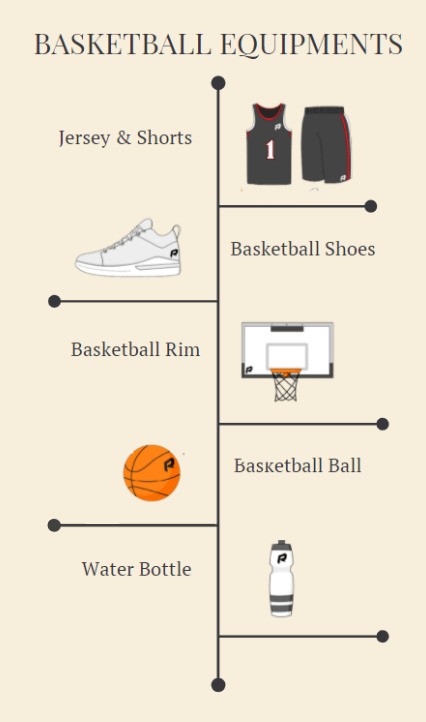
· Jersey and shorts
· Basketball Shoes
· Basketball Rim
· Basketball Ball
· Water Bottle
BASIC SKILLS
You can observe the basic skills showed by the players in the game between USA vs Serbia. Those basic skills are:
Dribbling
Dribbling is an important skill for all basketball players. This skill will allow you to move up and down the court, maneuver past defenders and execute plays. Proper dribbling requires ball-handling skills and knowledge of how to spread your fingers for ball control. It is also best if you know how to dribble equally well with both hands.
Shooting
In order to score points in basketball, you need to shoot the ball into the hoop. This requires the ability to properly hold and throw the ball into the air toward the basket while avoiding defenders. A proper shot requires precise aiming, arm extension and lift from the legs. There are different types of shots you need to learn, including jump shots, layups and free throws.
Running
Running is a big part of basketball. In a full-court game, you will find yourself running back and forth as the game quickly transitions between offense and defense. When you have the ball, running will help you to avoid defenders and get to the basket quicker. On defense, you often will find yourself needing to run after the opponent, especially during fast breaks.
Passing
Passing is another skill that when mastered can help you become a complete basketball player. Basketball is a team sport that involves finding a teammate who is open for a shot. The ability to pass the ball to this player can make the difference between scoring and not scoring. Really great passers are an important part of a basketball team and usually the ones who set up scoring plays.
Jumping
Jumping is another skill that can define how good a basketball player is. Jumping is involved in offense during the jump ball in the beginning, while taking shots and sometimes while trying to catch a pass. On defensive you will need the ability to jump when trying to block a shot or a pass. Being able to out jump your opponent for a rebound also is important.
TECHNICAL & TACTICAL SKILLS
From what I observed from the game, each of the player showcased their technical skills through their body movement competency, passing and receiving mastery, dribbling adroitness, shooting and rebounding skills, offensive and defensive ability. Most people only see the result of their hardwork through their technical skill. They don’t have knowledge on how hard each player worked for it each day. Blood, swear, tears and breakdowns were encountered by different players before arriving the different technical skills they have shown in the game. While a player has a technical skill, they also have tactical skill that helped both team manifest good transition of the play. Each team had different tactical skills depending on the situation and plays being shown by the opposing team. From what I have observed, USA showcased such tactical plays that help them beat Serbia such as having offense plays like handover, backdoor cut, 2 man play, 2 man game, Open play, and mostly shown tactical skill of the team USA is Man-screen roll over. The Serbia also showcased these tactical skills however, the USA did it better and executed it well. USA also had tactical skills in their defense like man to man defense and half-court press,1-3-1, switch and box defense. Both teams showed their different tactical and technical skills to have a smooth transition offense and defense.
RULES OF THE GAME
Rules for the Offense
The player must bounce, or dribble, the ball with one hand while moving both feet. If, at any time, both hands touch the ball or the player stops dribbling, the player must only move one foot. The foot that is stationary is called the pivot foot.
2) The basketball player can only take one turn at dribbling. In other words, once a player has stopped dribbling they cannot start another dribble. A player who starts dribbling again is called for a double-dribbling violation and looses the basketball to the other team. A player can only start another dribble after another player from either team touches or gains control of the basketball. This is usually after a shot or pass.
3) The ball must stay in bounds. If the offensive team looses the ball out of bounds the other team gets control of the basketball.
4) The players hand must be on top of the ball while dribbling. If they touch the bottom of the basketball while dribbling and continue to dribble this is called carrying the ball and the player will lose the ball to the other team.
5) Once the offensive team crosses half court, they may not go back into the backcourt. This is called a backcourt violation. If the defensive team knocks the ball into the backcourt, then the offensive team can recover the ball legally.
Rules of the Defense
.The main rule for the defensive player is not to foul. A foul is described as gaining an unfair advantage through physical contact. There is some interpretation that has to be made by the referee, but, in general, the defensive player may not touch the offensive player in a way that causes the offensive player to lose the ball or miss a shot.
Rules for Everyone
1) Although the foul rule is described above as a defensive rule, it applies exactly the same to all players on the court including offensive players.
2) Basketball players cannot kick the ball or hit it with their fist.
3) No player can touch the basketball while it is traveling downward towards the basket or if it is on the rim. This is called goaltending. (touching the ball on the rim is legal in some games).
OFFICIATING THE SPORT
The game between the USA vs Serbia was officiated by different officiating officials such as crew chief, referee, statistician, chairperson, scorer, assistant scorer, timekeeper and 24-second shot clock operator. The different officiating officials has different roles in officiating the game.
Crew Chief - The head official in basketball who is responsible for making the final decision of the game.
Referee - enforces the rules of the game and determines when a violation. or foul occurs and then stopping the game to issue the correct penalty.
Statistician - Records all the aspect of the game which is now usually done on a computer, tablet or smartphone or manually with a paper template.
Chairperson - Ensure the smooth operation on the scoretable and communicates with the referees.
Scorer - Completes the scoresheet
Assistant scorer - Assist with operating the scoreboard.
Timekeeper - Operate the game clock and in most situations also operate the scoreboard.
24-second shot clock operator - Operate the shot clock by stopping and resetting according to the rules.
OVERALL ANALYSIS OF THE GAME
The USA blew out Serbia with the score 96–66. The USA dominated the game consisting of mostly all star NBA players such as Kevin Durant, Demar DeRozan, Jimmy Butler, Kyle Lowry and Harrison Barnes. Both teams had shooting percentage with 48% consisting the team USA of 53.6% 2 points FG, 37.6% 3 points FG, 74.6 Free-throws while the team Serbia had 54.5% 2 points FG, 35.7 3 points FG and 77.7% Free-throws. Talking about the rebounds, team USA had 29 defensive rebounds and 16 offensive rebounds having a total of 44 rebounds while the team Serbia had 25 defensive rebounds and 11 offensive rebounds having a total of 36 rebounds. The team USA had 20.7% points from turnover, 19.6 fast break points, 19.1 second chance points, 39.4 % points in the paint and a 27.3 biggest lead. On the other hand, team Serbia had 16.9% points from turnover, 14.1 fast break points, 10.4 second chance points, 38.9 % points in the paint and a 19.1 biggest lead. The USA vs Serbia manifested an adequate good skills, team tactics and techniques, however in every game there will always be a loser or winner which the USA entitled the success while the Serbia had a downfall because of losing the game, but people where not discourage with the result for the Serbian played their hearts out and fought for their country’s name and showed their true love and passion in basketball.
REFERENCES:
OFFICIAL, N.(2020). NBA OFICIAL. Retrieved from official.nba.com:https://official.nba.com/rulebook/
Stewart, T. (2018, December 11). The Five Basic Skills of Basketball. Retrieved from SportsRec: https://www.sportsrec.com/8072917/the-five-basic-skills-of-basketball
1 note
·
View note
Text
SEA GAMES 2019: PHL vs VIE Volleyball Women Opener
The game between the two opposing team pleasured many people watching the game as both of the team are fighting to reach victory as they represent their country.
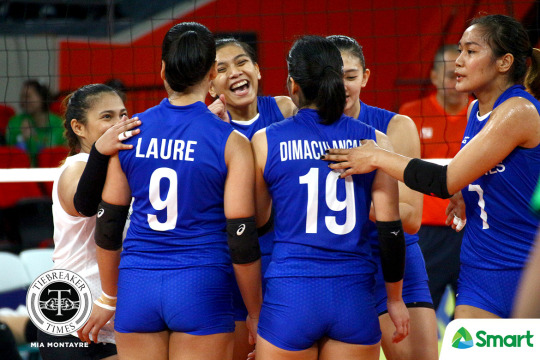
This is a volleyball analysis of the game which happened last December 3, 2019.
Link of the game: https://www.youtube.com/watch?v=Gm4kGC_d-i8
Court Dimension
Philippines faced against Vietnam in the 2019 SEA Games Women’s Volleyball opener which was held at the Philippine Institute of Sports Multi-Purpose Arena. The Philippines Sports Arena has a volleyball court having the dimension of 9 meters wide by 18 meters long or 9m x 18m. The court is divided into two equal halves by a net having a height of 2.2 meters.
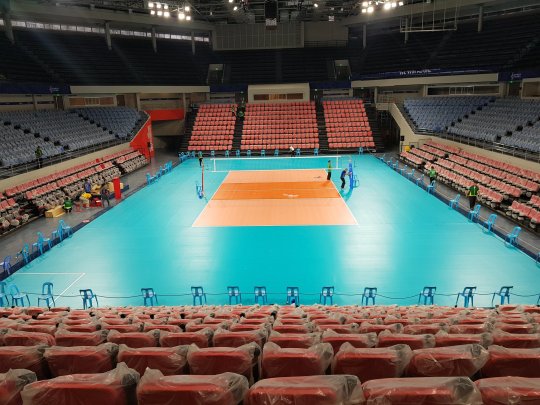
Equipment
· Shoes
· Uniform
· Knee Pads
· Elbow Pads
· Ball
· Net

Basic Skills
Basic Skills are present in both teams Philippines and Vietnam. They showed the basic skills such as:
Passing is often thought of as the most important skill in volleyball. If you can’t pass the serve, then you won’t ever put your team in a position to score a point.
Blocking is perhaps the least taught skill in volleyball. Players can get away with poor blocking skills because not blocking isn’t going to hurt the team as much as being poor at executing other skills in volleyball.
Setting is done to either dump the ball over into an undefended spot or to “set” the ball into a position that allows the hitter to spike it over.
Spiking is the act of scoring a point by slamming the ball over the net into the opposing court effectively and aggressively.
Digging is preventing the ball from hitting the floor after being spiked by the opposing team.
Serving is done by using one, open hand to swing overhead and send the ball over the net from behind the end line.
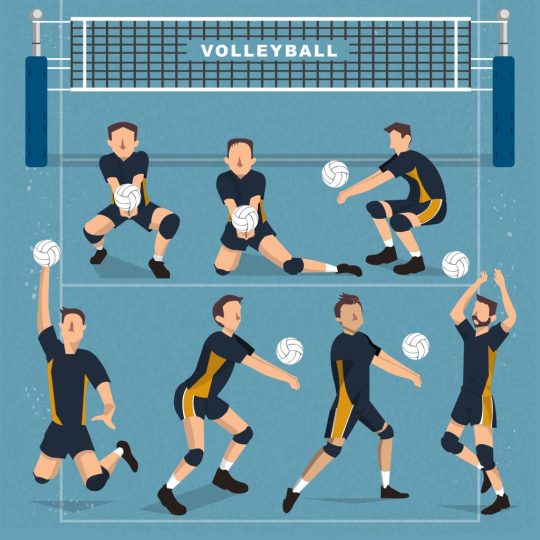
Rules of the Game
Volleyball Rules
6 players on the floor at any one time - 3 in the front row and 3 in the back row
Maximum of 3 hits per side
Points are made on every serve for wining team of rally (rally-point scoring).
Player may not hit the ball twice in succession. (A block is not considered a hit.)
Ball may be played off the net during a volley and on a serve.
A ball hitting a boundary line is in.
A ball is out if it hits an antennae, the floor completely outside the court, any of the net or cables outside the antennae, the referee stand or pole, the ceiling above a non-playable area.
It is legal to contact the ball with any part of a player’s body.
It is illegal to catch, hold or throw the ball.
A player cannot block or attack a serve from on or inside the 10-foot line.
After the serve, front-line players may switch positions at the net.
Matches are made up of sets; the number depends on level of play.
3-set matches are 2 sets to 25 points and a third set to 15. Each set must be won by two points. The winner is the first team to win 2 sets.
5-set matches are 4 sets to 25 points and fifth set to 15. The team must win by 2 unless tournament rules dictate otherwise. The winner is the first team to win three sets.
Volleyball Rules Violations
Stepping on or across the service line when serving while making contact with the ball.
Failure to serve the ball over the net successfully.
Ball-handling errors and contacting the ball illegally (double touching, lifting, carrying, throwing, etc.)
Touching the net with any part of the body while the ball is in play.
Blocking a ball coming from the opponent’s court and contacting the ball when reaching over the net if your opponent has not used 3 contacts AND has a player there to make a play on the ball.
Attacking a ball coming from the opponent’s court and contacting the ball when reaching over the net when the ball has not yet broken the vertical plane of the net.
Crossing the court centerline with any part of your body, with the exception of a hand or foot. It is only considered a violation if the entire hand or entire foot crosses the court centerline.
Serving out of rotation or out of order.
Back row player blocking (deflecting a ball coming from the opponent) when, at the moment of contact, the back row player is near the net and has part of their body above the top of the net. This is an illegal block.
Back row player attacking a ball inside the front zone (the area inside the 3M/10-foot line) when, at the moment of contact, the ball is completely above the net. This is an illegal attack.
Officiating the Sports
- Referees
Before starting the game, there were two referees being introduced. First referee was named Leung Yin Yan and the second was Agung Purwanto. They were both responsible for officially recognizing team requests, substitutions, time-outs and communicating with the coaches at the appropriate times.
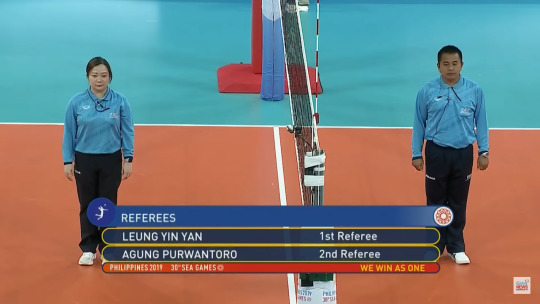
( A screenshot of the video: https://www.youtube.com/watch?v=Gm4kGC_d-i8)
- Scorekeeper
The scorekeeper creates official records of volleyball games. Before play begins, the scorekeeper records team and player information. Once the game begins, scorekeepers not only track points, but also player substitutions, sanctions and time-outs. The scorekeeper keeps an eye on the individual serving the ball to track the rotation and notify referees of potential lapses. At the close of the game, the scorekeeper records the final score of the game.
- Assistant Scorekeeper
The assistant scorekeeper or libero tracker is responsible for updating the scoreboard and keeping an eye on the libero. This individual records changes in the libero rotation, notifying referees when problems occur in the rotation.
- Line Judges
There are usually two line judges, one at either end of the court, usually in opposite corners. Line judges work with the referees, signaling to assist in making judgment calls. These officials often use flags to signal when a ball is in or out, hits the antennae of the net, or when the server commits a foot fault, or steps outside the line as they serve.
Technical and tactical skills
As the game started both teams had technical skills in order to have a systematic play to be an effective team in the game. They have both unique technical skills as the two opposing team showcased their strength and abilities. During the game, the Philippines was finishing strong at the first set through great communication through the athletes in the team and they also constructed opening opinion to beat the opposing team. On the other hand, the team also displayed correct-decision making skills to sustain the game until reaching the victory. The team were always open to being guided when one fails to do so. Both teams exhibit the ability to read the play or situation and in acquiring the knowledge needed to have a proper tactical decision.
Summarization
The game was started with the big six of the two teams in the Philippines containing: Jovelyn Gonzaga, Mary Joy Baron, Frances Molina, Alyssa Valdez, Abigail Maran, and Rhea Dimaculangan. While the team Vietnam was containing: Thi Kim Dang, Thi Nga Bui. Thi Xuan Nguyen, Thi Thanh Tran, Thi Trinh Nguyen, and Thu Hoai Nguyen. The game was started with the possession of the Philippines having the first serve by Dimaculangan. The game heated up when the Philippines got the first point on the first round and another one through the spike that was unable to be block by the Vietnam. The Philippines won the first set with a 25-21, but the Vietnam didn’t give up as they got the 2nd and third set with the score 23-25 I the 2nd set and 19-25 in the 3rd set which leads the downfall of Filipinos as the Vietnam got the last set scoring 8-15. Vietnam got the victory and it ended up showing true sportsmanship and sharing the passion of their true love of the game between Philippines and Vietnam.
References:
Strength and Power for Volleyball. (n.d.). Retrieved from strength-and-power-for-volleyball: https://www.strength-and-power-for-volleyball.com/basic-volleyball-skills.html#:~:text=The%20six%20basic%20volleyball%20skills,of%20serving%20is%20often%20undervalued.
AOC Volleyball. (2018, November 23). Retrieved from theartofcoachingvolleyball: https://www.theartofcoachingvolleyball.com/basic-volleyball-rules-and-terminology/
Photo Credits:
https://www.facebook.com/gmanews/posts/look-volleyball-court-sa-philsports-arena-na-isa-sa-mga-venue-sa-seagames2019-ha/10158104822721977/
https://tiebreakertimes.com.ph/tbt/philippines-falters-t4-led-vietnam-sea-games-volleyball-opener/172413
https://sportamix.com/blog/top-10-volleyball-skills/
1 note
·
View note
Photo

SPORTS BLOG
A tightrope championship battle with a race to 4 wins to get the NBA Playoff Champion title of the year 2020 between Los Angeles Lakers and Miami Heat was held in the ESPN Wide World of Sports Complex Bubble with a court dimension of 94 feet long by 50 feet wide. The players of both teams had basketball equipments such as water bottle, towel, team jersey and shorts together with their socks and shoes and two basketball rims on both sides of the court played with a basketball ball. Both teams were trained hard to improve their skills towards the game such as dribbling, shooting, running, passing, jumping, lay ups, cutting and footwork. These skills will help the team to have a higher chance of winning together with their coordination with one another as basketball is known as a team sport. Each player showcased their technical skills through their body movement competency, passing and receiving mastery, dribbling adroitness, shooting and rebounding skills, offensive and defensive ability. The two opposing team manifested different tactical skills as they act accordingly to the situation of each game and having knowledge about the game plans to know the strength and weaknesses of the opposing team. They have shown different tactical skills such as backdoor cut, give-and-go, handover, screens, box play, 1-3-1 and transition offense and defense. In order to keep a smooth transition between offensive and defensive play, one must know the rules of the game particularly double dribble, traveling, foul, illegal screen, back-court violation, on and off court violation, out of bounce, 3 seconds violation, kickball, goal tending and time restrictions. These rules will be called under an officiating official (referee). There are different kinds of officiating officials that officiates the game and these are the statistician who records all the aspect of the game; chairperson who ensures the smooth operation in the score table; scorer who completes the scoresheet; timekeeper who operates the game clock; 24-second shot clock operator who operates the shot clock and a referee who enforces the rules of the games. The NBA Playoff Champion title of the year 2020 was entitled to the Los Angeles Lakers as they finally put away a daunting, dangerous and worthy Miami Heat with a score of 106-93 in game 6 of the NBA Finals. To come to an end, analyzing the game between the Los Angeles Lakers and Miami Heat was entertaining as it shows my true love for this sport.
1 note
·
View note
Photo

Should schools use electronic textbooks to save paper?
This is a controversial topic but it is definitely not rocket science. Both have pros and cons but one excels over the other. Just like dealing with pharmaceutical medications, physicians prescribe certain medicines and pharmacists produces millions of those pills because the benefits outweigh the side effects. Without the advancement of technology, we have been using the traditional way of learning through hard copies of textbooks by bringing them to school every single day. We all know that paper books are not good for the environment. It harms us all by bringing more problems in relation to waste disposal and management. The thing about the traditional printed textbooks is that usually, minor and major revisions have to be made so that old versions can make way for the new ones, therefore disabling and terminating the usage of the not updated copies of those textbooks, which makes them not usable anymore. Shortages of textbooks or delays in the distribution to different institutions can affect the teaching-learning experience.
On the other hand, transitioning from paper books to electronic books bring us much closer to the idea of an eco-friendly surroundings. We will be the superheroes of the modern world by minimizing the use of harmful products in our activities of daily living. Switching to electronic books have so many advantages because it is an interactive way of learning. Students are able to have the freedom to bring only one device instead of heavy books to school. They are allowed to highlight important details without using another writing material. With the help of the internet, online search engines are easily accessible for students having a hard time looking up terms on the textbooks. Digital textbooks eliminate the extra costs of shipping, delivery and distribution. Instead of wasting time dealing with the printing of millions of copies of textbooks, why not invest the money for teachers and students to have additional funds for resources and after-school programs.
Thinking about the long run, small things done consistently yield great results. Each moment of every day presents us with possibilities to change our bad habit of using paper by modifying it through electronic textbooks which allows us to improve things in work and life. It does not only benefits people, but also to our mother nature as it helps us reduce our carbon footprint and helps to prevent trees from being cut down and eliminates the energy that is used to convert a tree into a piece of writing paper. Using of electronic textbooks to save paper may not be the best solution, but a life will never change until you change something daily.
References:
Baragar, A. (2019, December 09). Teach Hub. Retrieved from teachhub.com: https://www.teachhub.com/technology-in-the-classroom/2019/12/the-advantages-of-digital-textbooks/
HIgh Sierra Business Systems. (2018, August 20). Retrieved from hs-business.com: https://www.hs-business.com/5-benefits-of-using-less-paper-in-the-office
Image source:
https://www.google.com/search?q=e+textbooks&sxsrf=ALeKk01SdgIaxqJt1o-lZPsxbxzAaYuHIQ:1611535644517&source=lnms&tbm=isch&sa=X&ved=2ahUKEwiPhomN7rXuAhUDGKYKHb9iDUkQ_AUoAXoECCMQAw&biw=1536&bih=754#imgrc=dZOxaglyuKd0LM
0 notes
Text
Types of Speech
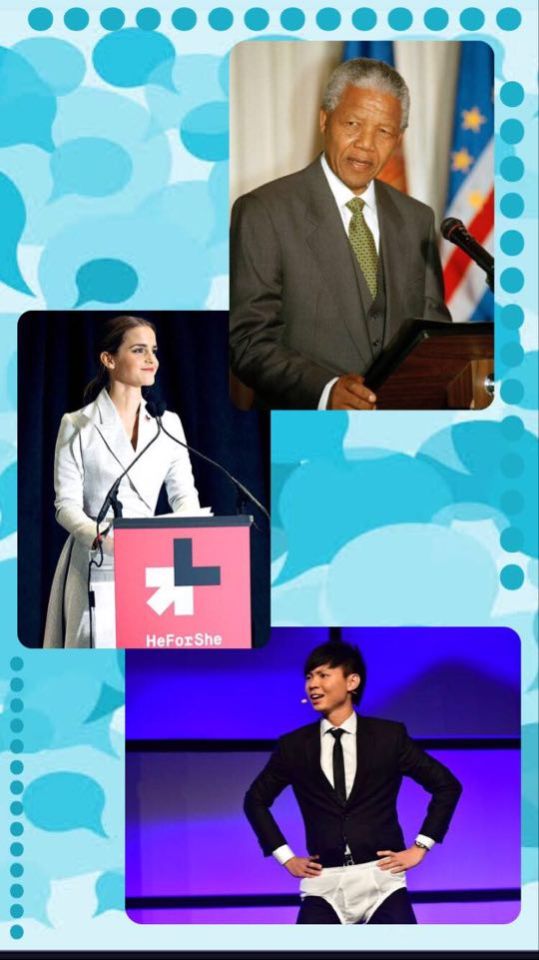
Three people delivered a rousing speech, Nelson Mandela, Emma Watson and Darren Tay Wen Jie. Each of their speech was delivered uniquely because each of them has a purpose and a way on how to deliver their speech to the people. Their speech may be different with each other, but they have one goal, and that is to let people know what are they trying to convey or what is the message they want to impart to the audience.
After watching the video and analyzing each of their speech, their speech varies with their purpose. Nelson Mandela had an Informative Speech, since he was informing the audience about freedom and justice during in his time. Mandela successfully delivered his speech through informing/delivering the audience about how he made a big impact of the unfair relationship between Africa and United States. He expressed that all of them must have a good relationship that is respecting each other despite the color, since all people are equal. Talking about Emma Watson’s speech, she had a different way of delivering her speech, she did it through persuading people about “Gender Equality & Feminism”. She was trying to persuade that women should fight for their rights and women should have equal opportunities with men. About Darren Tay Wen Jie’s Speech, it was an Entertainment Speech because he made people put a smile on their faces with his different jokes and at the same time teaching valuable lessons about bullying.
They all delivered their speeches competently. They satisfied their audience with their concept or the purpose why they are delivering a speech, either to persuade, inform, entertain or etc. All of them achieved their purpose in delivering a speech to the audience. In Nelson Mandela’s speech, he was trying to convey to the audience about the discrimination between the black people and the white people. He was able to achieve his purpose in delivering his speech as the audience showed a ton of emotions. In Emma Watson’s Speech, she achieved her purpose in delivering the speech by sharing her experiences and persuading the women to always fight for their rights. Through her way of delivering the speech, she caught the attention of the audience especially to women. Last but not the least, about the speech of Darren Tay Wen Jie. He achieved his purpose in delivering his speech by keeping in touch with the audience through his different jokes. It was not only his jokes that made his audience listen to him but also about how meaningful his speech was, about what you should do when bullies come. His speech does not only apply to bullies, but also to the obstacles that we face in our everyday lives.
Besides, each of the speaker has different manner of delivering their speeches. Nelson Mandela delivered it through bringing a manuscript during his speech, but despite using a manuscript, he still managed to engage the relationship of him and the audience by glancing at the viewers from time to time. About the manner of Emma Watson delivering a speech was through a memorized one. Since she was maintaining an eye contact to the audience all throughout her speech. Lastly, Darren Tay Wen Jie has a manner of delivering a speech just like Emma Watson since his speech was a memorized one. It can’t be identified if either it was an impromptu or an extemporaneous speech because he was more likely to be ready and was even able to bring a prop during his speech.
1 note
·
View note
Text
MGA CEBUANO

Mahalagang magkaroon ng ganitong kaalaman sa wika, paniniwala, pamumuhay, tradisyon at kultura ng ating pangkat kultural sapagkat mas nabubuksan natin ang ating kaisipan at mapalawak ang kaalaman tungkol sa iba’t-ibang pangkat kultural sa bansang Pilipinas.
0 notes
Text
CEBUANO
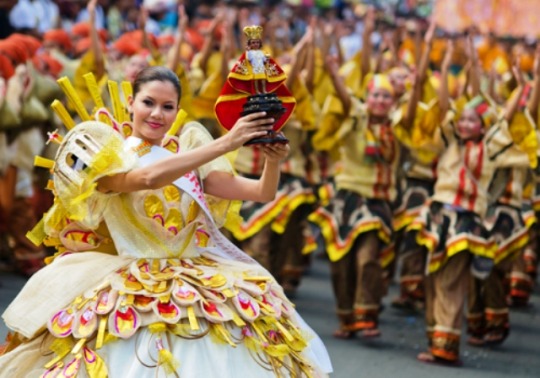
Ang iba't ibang mga pangkat-etniko sa Pilipinas ay kinikilala ang kanilang sarili sa isa o higit pa na mga salik katulad ng lipi, wika, relihiyon o sa isang magkatulad na kasaysayan. Binubuo ito ng iba’t-ibang pangkat kagaya ng mga Ivatan, Tagalog, Cebuano, Tausug, at iba pa. Ako ay kabilang sa pangkat kultural na Cebuano kaya papalawakin ko ang inyong kaalaman ukol sa aming pangkat kultural.
Ang Cebuano ay galing sa pangalan ng Philippine island ng Cebu at ang Espanyol na hulapi “ano” na ang ibig sabihin ay “native of”. Ang mga Cebuano, tinatawag din Sugbuanon o Sugbuhanon, ay ang pangalawang pinakamalaking pangkat etnolinggwistiko dito sa Pilipinas, na bumilang sa higit 16.5 milyon. Ang mga Cebuano ay tumira sa mga isla ng Cebu, Siquijor, Bohol, pati na rin sa silangang Negros, kanlurang Leyte, timogang Masbate at hilagang Mindanao.
Ang mga lugar na ito ay may tanyag na anyong tubig at lupa kaya maraming mga tao ang puwedeng makakahanapbuhay dito kagaya ng pagsasaka, pangingisda, pagmimina at iba pa. Ang kanilang wika ay sangay ng pamilyang wika ng Austronesian (Malayo-Polynesian) na may malaking inspirasyon mula sa Wikang Espanyol, ngunit mayroon rin itong mga salitang kinuha mula sa Wikang Ingles. Mayroon din silang mga paniniwala, kagaya ng paglagay sa gitna ng mga pahina ng bibliya o kahit anong libro ang unang gupit ng buhok ng bata upang siya ay lumaking mahilig magbasa.
Karamihan sa mga Cebuano ay mahilig sa iba’t-ibang pagdiriwang na humubog sa kanilang kultura. Halimbawa nito ay ang sikat na piyesta na kinikilala na “Sinulog Festival”. Ito ay itinuturing na una sa pinakatanyag na pagdiriwang sa Pilipinas na nagaganap taon-taon na nakaakit ng halos 1-2 milyong katao mula sa buong Pilipinas. Bukod sa relihiyosong aspeto ng pagdiriwang, ang Sinulog ay sikat din sa mga street party nito, na karaniwang nangyayari sa gabi. Ang mga Cebuano ay may malaking respeto sa kanilang kapwa tao kaya nagkakaroon ng interaksyon at ugnayan para mapanatili ang kanilang pinagyaman na kultura.
Mahalagang magkaroon ng ganitong kaalaman sa wika, paniniwala, pamumuhay, tradisyon at kultura ng ating pangkat kultural sapagkat mas nabubuksan natin ang ating isipan at mapalawak ang kaalaman tungkol sa iba’t-ibang pangkat kultural sa bansang Pilipinas.
0 notes
Photo

Effective TV news anchor
Noli de Castro is an anchorman of TV Patrol and sooner he became a sole anchor of the newscast in DZMM. He is not only a news anchor, but also an overall head of production and became the vice president of DZMM. He was a former vice president and decided to retire from politics at the end of his vice presidential term and intended to commit himself full time to broadcast journalism.
He has confidence in reporting and deliver news statements with a unique style of talking. His way of reporting is effective because of his voice modulation and he understand the news report first before delivering it to the audience to avoid being a “biased” news anchor. Noli is also good in processing information and also the ability to simultaneous task while he is reporting and at the same time taking in the producer’s instructions. He always shows the he really loves what he is doing and he shows a good body language which makes him an effective new anchor.
Noli de Castro’s job is not easy, but he shows that there is no hindrance in doing what you love and serving people. He has a nickname called “Kabayan Noli” because of his love for being a news anchor and proves people that no matter how stressed or tired you are, life must go on and do always what you love.
1 note
·
View note
Text
Conic Sections
Our first lesson in Pre- Calculus as a senior high school student is about “Conic Sections”. I have no knowledge or background about this lesson because this is a new lesson to me. Our teacher discussed to us what is “Conic Sections” all about and I’ve learned something about Ellipses, Circles, Parabolas and Hyperbolas. These conic sections are represented by mathematical function and it is also about graphing and changing general form to standard form and vice versa. This topic was boring at first not until I knew that this can also be seen in reality, such as the architectures just like buildings and in different objects. In short, Conic Sections are mostly everywhere. What makes it more interesting is because of the different architectures that are based on a conic section which makes it mesmerizing, one of it is the Opera House in Sydney. Besides, Conic Sections are not only used or found in Mathematics but also in other fields like architecture and engineering.

DETAILS:
CIRCLE: Wheel; Living room of our house
CIRCLE: Plate; Balcony of our house
ELLIPSE: White Platter; Balcony of our house
ELLIPSE: Green Platter; Balcony of our house
PARABOLA: Nose of the longboard; Living room of our house
PARABOLA: Weighing scale bowl; Balcony of our house
1 note
·
View note
Text
The King’s Speech: Synopsis & Analysis

Synopsis:
A true story film entitled “The King’s Speech”, showed the hardships of King George who was once called (Highness Prince Albert of York). This story manifested about how a man encountered his problems from his disability to speak properly. It was showed in the film that King George struggled speaking in public due to his stammering problem. He spent his childhood or mostly his life stammering which leads him to feel down but it didn’t become a hindrance for him to not continue in life. King George consulted with numerous speech therapists who could help him cure his disability, but the therapists was not able to help him. King George almost lost his hope thinking that he will forever stutter in his whole life not until the president of speech therapist in England has recommended a therapist that could possibly help him, the therapist is named “Lionel Logue”. The therapist helped him and King George went through different treatments. Lionel made the first treatment in a way the he gave a head phones with music so that he could not listen to his own voice. King George got mad at Lionel saying that his treatment is useless not until when he heard the recorded disk that he spoke without stammering. As time passes by, they created an unexpected friendship. Sadly, his father died, making his brother the new king. In a short time, his brother decided to stop being a king because he wanted to marry the girl he loved the most. There’s no other person that can replace his brother but only him. He faced his fear and became the king of England. He overcome with his fears in life and got into a wonderful life after facing his fears.
Analysis:
The film was not just only a film, it is an extraordinary film that has a great lesson to everyone. You can observe the interference of the elements and dimensions of communication and miscommunication. The movie is highly recommended to everyone especially to those people who suffer from having a hard time to speak well because of stammering. Life of a person who lives with the disability not to talk properly is so hard, King George didn’t fail to show it. From his childhood experiences until he grew up, he lived a difficult life that hoping that one day he will wake up living a normal life. Most people who suffer just like his disability don’t live longer because of losing hope that they can still be treated. King George maintained his positive mindset that he can still be cured and also with the unending support that is being showed by his wife (Elizabeth), instead of judging King George because of his disability, Elizabeth loved him with all her heart and accepted King George as a whole. Analyzing the film, it has noise that interferes the communication which caused King George having a hard time to communicate with someone. Another is the facial tics that he creates when he tries to speak making the listener have a hard time to understand him. In the first scene, it is shown that King George is having a hard time to speak in front of crowd. Since he is stammering, I can observe how the people react when the time that King George spoke. The people had the feeling of awkwardness and fiddly. The movie showed how severe is the disability of King George is, he went through different speech therapist, but only one helped him improve among all the speech therapist he consulted and he is Lionel Logue. He made improvements of the way on how King George speaks and they went through different sessions in order to make changes. If you really understand on how King George speaks, it really depends with the environment because King George speaks better and has an improvement when they are together with Lionel unlike when King George is delivering a speech in front of a crowd. King George didn’t lose hope and trusted Lionel in his way on how to cure him. In the end when the time that King George is about to deliver a speech about how Britain is going to deal with the crisis, he proved the people wrong who doubted him and shocked the crowd when he delivered the speech well. The movie has plenty of life lessons that made the movie more interesting, just like trusting the process, loving someone unconditionally, never doubt people who is trying to improve, and believing in yourself. In life all we need is someone who will always be there for us and accepts us for who we are, just like Elizabeth and Lionel.
Advocacy:
The film's advocacy aims to target audience with physical and mental disabilities and how these pose as a challenge in their daily lives. We all have challenges that we face in our lives, and it is up to us on how are we going to take it on: face the problem and strive for success, or fear disappointment and lose right away. Lastly, the advocacy of the film is more about the people who are doubting themselves because of their disabilities and how these said disabilities shouldn't be considered as boundaries, but instead as walls that can be moved.
1 note
·
View note